Please Report Any Broken Links Or Trouble You Might Come Across To The Webmaster.
Please Take A Moment To Let Us Know So That We Can Correct Any Problems And Make Your Visit As Enjoyable And As Informative As Possible.
| Click On Image For Full Size Image | Size | Image Description | Contributed By And/Or Copyright |
|
|---|---|---|---|---|
| Keel Laying / Commissioning 1911 - 1914 |
||||
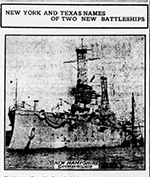 | 1.07k | NEW YORK AND TEXAS NAMES OF TWO NEW BATTLESHIPS Washington, December 16. New York and Texas are the names of the two new battleships authorized at the last session of congress. Texas will be the name of the vessel which, as provided by the last naval bill, will be constructed by a private contractor while the New York dreadnought will be built by the government at the New York navy yard. This selection of names for the two most powerful vessels in the United States navy, which was made by Secretary of the Navy Meyer, will necessitate the changing of the designations of two warships already in commission, for at present there is the Texas, a second class battleship, which will be renamed San Marcos in honor of a city of Texas. Her displacement is only 6,315 tons, while the new Texas will be of 27,000 tons displacement. The present cruiser New York will be rechristened the Manhattan. The New Hampshire (BB-25), (pictured) one of the crack ships of Uncle Sam's navy, will be a dwarf beside the New York and the Texas. The two new battleships will be nearly 10,000 tons heavier. | Image and text provided by University of Florida. Photo from the The Pensacola Journal. (Pensacola, Fla.) 1898-1985, 17 December 1910, Image 6, courtesy of chroniclingamerica.loc.gov. | |
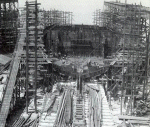 | 77k | 1 July 1911 photo of the Texas (BB-35) being built. Sub-assemblies and machinery area bulkheads are in place. | USN photo contributed by Mike Green, courtesy of Leeward Publications. | |
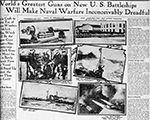 | 730k | World's Greatest Guns On New U.S. battleships Will Make Naval Warfare Inconceivably Dreadful | Image and text provided by University of Utah, Marriott Library. Photo from the The Salt Lake Tribune. (Salt Lake City, Utah) 1890-current, 17 September 1911, MAGAZINE SECTION, Image 51, courtesy of chroniclingamerica.loc.gov. |
|
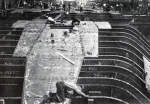 | 57k | Looking forward from the stern, this 2 October 1911 photo shows the angled framing of the tiller room. | USN photo contributed by Mike Green, courtesy of Leeward Publications. | |
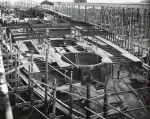 | 69k | 12 January 1912 photo of Texas (BB-35) being built. This photo shows the second deck around #4 and #5 barbettes. The tiller room at the bottom edge of the photo has been completely plated over. | USN photo contributed by Mike Green, courtesy of Leeward Publications. | |
 | 89k | Texas (BB-35) on 2 April 1912 almost hidden by scaffolding. The ramp at the left is used by mules hauling material to the main deck. | USN photo contributed by Mike Green, courtesy of Leeward Publications. | |
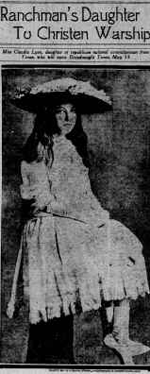 |
NR | Ranchman's Daughter To Christen Warship. | Image and text provided by University of California, Riverside. Photo & text by The San Francisco Call.(San Francisco [Calif.]) 1895-1913, 29 April 1912, Image 9, courtesy of chroniclingamerica.loc.gov. |
|
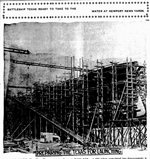 |
NR | BATTLESHIP TEXAS (BB-35) READY TO TAKE TO THE WATER AT NEWPORT NEWS YARDS | Image and text provided by State Historical Society of North Dakota. Photo by Bismarck Daily Tribune. (Bismarck, Dakota [N.D.]) 1881-1916, 20 May 1912, Image 1, courtesy of chroniclingamerica.loc.gov. |
|
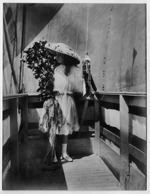 013500h | 1.76k | Photograph of Claudia Lyon holding a large bouquet and a bottle attached to a rope. A handwritten note on the back of the photo says "Miss Claudia Lyon, aged 10 years. Daughter of Col. Cecil A. Lyon, American statesman, and niece of C. Otto Forster Braun of Springfort. Sponsor at launching of U.S. battleship Texas (BB-35) - largest vessel in American Navy and first to carry the new 14-inch guns. Youngest person to act as sponsor at launching of a vessel in American Navy. This photo shows the little girl in launching booth and holding champagne bottle in hand." | Photos courtesy of Texas History Website TXPWD_1988-15-21 & loc.gov via Robert Canchola. | |
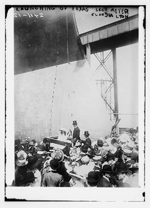 | 483k | Launch of Texas (BB-35), Sec. of Navy Meyer and Claudia Lyon. Arrival of the blessed moment: Texas gets a peck on her bow by Claudia Lyon. | Digital ID # ggbain 10503, LC-B2-2411-12. Source: Library of Congress Prints and Photographs Division, from the George Grantham Bain Collection. Insert photo Author's collection. | |
 013511 |
740k | A very young sponsor & maids of honor of the battleship Texas (BB-35) . Sponsor: Miss Claudia Lyon, the young daughter of Colonel Cecil Lyon, Republican National Committeeman from Texas. Miss Mary Colquitt, daughter of Governor O. B. Colquitt of Texas, Miss Mae Furey, Miss Ura Link and Miss Garland Bonner were Maids of Honor. General Manager Homer G. Ferguson of the Shipbuilding Company initiated little Miss Lyon in the art of breaking the bottle. Among those present were Miss Helen Taft, daughter of President Taft, Secretary of the Navy George von L. Meyer, Secretary of the Treasury Franklin MacVeagh, Colonel B. T. Bonner, representing Governor Colquitt. Richmond Pearson Hobson, Naval hero and Congressman, responded to one of the toasts. Fifteen thousand people witnessed the launching. One of the interesting features of the launching was the taking of motion pictures of a launching for the first time, and the releasing of the ship by two massive steel triggers instead of the sawing away of blocks. |
Text & photo courtesy of Sponsors of the United States navy; Benham, Edith Wallace, comp; Hall, Anne Martin, comp 1797-1913, pg. 264. via Neport News Shipbuilding Company courtesy of Boston Public Library. | |
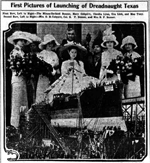 |
NR | First Pictures of Launching of Dreadnought Texas (BB-35) First Row, Left to 'Right: The Misses Garland Bonner, Mary Colquitt, Claudia Lyon, Ura Link, and Mae Tuny. Second Row, Left to Right Mrs. O. B. Colquitt, Col. B. F. Bonner, and Mrs.B. F. Bonner. The Times Herewith Prints the First Pictures of the Launching of the Battleship Texas at Newport News Yesterday. This Vessel Is the Largest Dreadnought of the United States Navy. | Image and text provided by Library of Congress, Washington, DC. Photo from The Washington Times. (Washington [D.C.]) 1902-1939, 19 May 1912, Sunday Evening EDITION, Image 1, via chroniclingamerica.loc.gov. | |
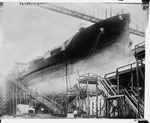 | 149k | A workman dangles from the bow of the Texas (BB-35) just above the sponsor's platform for the launching of the battleship sometime shortly before 18 May 1912. | Digital ID # ggbain 10418, LC-B2-2401-3. Source: Library of Congress Prints and Photographs Division, from the George Grantham Bain Collection, courtesy of Tom Kermen. | |
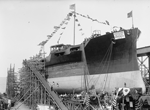 | 1.82k | Texas (BB-35) soon to part the weighs. | Reproduction Number, LC-DIG-hec-00797. Photo courtesy of loc.gov via Daniel Hacker. | |
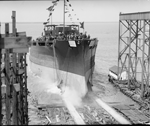 | 1.78k | Launching of the Texas (BB-35) . Harris & Ewing, photographer, 1912. | Reproduction Number, LC-DIG-hec-00796. Photo courtesy of loc.gov via Daniel Hacker. | |
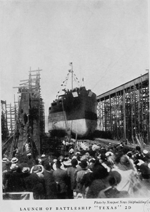 013500j |
797k | The Texas (BB-35) slides down the launching ways on 18 May 1912. | Photo courtesy of Sponsors of the United States navy; Benham, Edith Wallace, comp; Hall, Anne Martin, comp 1797-1913, pg. 260. via Neport News Shipbuilding Company courtesy of Boston Public Library. Insert PDF image and text provided by University of Illinois at Urbana-Champaign Library, Urbana, IL. Text courtesy of the Rock Island Argus., (Rock Island, Ill.) 1893-1920, 24 May 1912, HOME EDITION, Image 14, courtesy of memory.loc.gov. | |
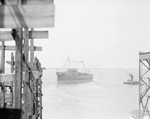 | 341k | Texas (BB-35) afloat after launch. | Photo courtesy of old-picture.com. |  | 675k | Starboard Bow view of Texas (BB-35) moored at pier during construction, 3 September 1912. | National Archives Identifier: 52556633 Local Identifier: 181-V-0862 Photo courtesy of catalog.archives.gov |
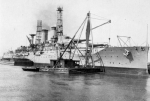 | 66k | Texas (BB-35) on 2 October 1912 being fitted out. A floating derrick is being used to install deck equipment. | USN photo contributed by Mike Green, courtesy of Leeward Publications. | |
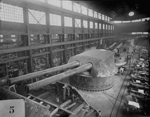 |
1.47k | Turrets of the New York (BB-34) & Texas (BB-35) under construction. | Photo courtesy of the Naval General Board via Yu Chu. | |
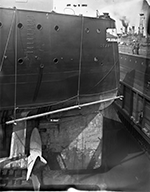 | 829k | Texas (BB-35) in Dry Dock; Stern View with Screw Showing; 9 April 1913. | National Archives Identifier: 52556681 Local Identifier: 181-V-0897 Photo courtesy of catalog.archives.gov |
|
 |
2.22k | Uncle Sam Buys Only the Best for His Sailor Boys That's Why He Installed McKEE REFRIGERATORS On the Battleships of the Navy At sea the health of a thousand men depends on the keeping of food for weeks food is only as pure as the refrigerator keeps it. On the cleanliness of your refrigerator depends your family's health. If government experts select the McKee, why don't you investigate the reason.they believe them most sanitary of all refrigerators. All sizes for all purposes. The Battleship "Texas (BB-35)," One of the Newest and Finest Ships. |
Image and text provided by Library of Congress, Washington, DC. Photo from Evening Star. (Washington, D.C.) 1854-1972, 11 May 1913, Image 17, via chroniclingamerica.loc.gov. | |
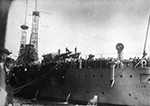 | 1.15k | Texas (BB-35), alongside the pier. | USN photo # Lot 10788-7, George C. Bain Collection, Courtesy of Library of Congress, from the National Museum of the U.S. Navy via flickr.com. | |
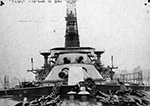 | 592k | Texas (BB-35) 14" guns on the bow, undated. | USN photo # Lot 10788-3, George C. Bain Collection, Courtesy of Library of Congress, from the National Museum of the U.S. Navy via flickr.com. | |
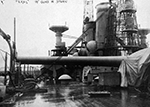 | 502k | Texas (BB-35) 14" guns on the stern, undated. | USN photo # Lot 10788-4, George C. Bain Collection, Courtesy of Library of Congress, from the National Museum of the U.S. Navy via flickr.com. | |
 013513i |
1.81k | Spectators on Texas (BB-35) at Maine exercises, between ca. 1912 and ca. 1915. | Reproduction Number: LC-DIG-ggbain-19246 Photo courtesy of loc.gov | |
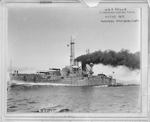 | 747k | Texas (BB-35) standardization trial, 27 October 1913; Run # 24, Speed 21.792 knots. | US National Archives photo # 80-G-1035094 from NARA, College Park, Maryland, courtesy of Sean Hert. | |
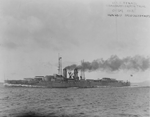 013530 |
697k | Standardization trial, Run No. 27, speed, 20.033 knots. NEW DREADNOUGHT MAKES RECORD IN SPEED TRIALS The new dreadnought, Texas (BB-35), the newest and largest addition to the American navy, had her recent speed trials during the battle practice of the Atlantic fleet off the Virginia Capes and came up to the requisite tests in good shape. She will be manned by a picked crew from the Idaho (BB-24), thus doing away with the tedious job of training a green crew. | National Archives Identifier: 496081290 Local Identifier: 19-N-6-24-19 Photo courtesy of catalog.archives.gov Image and text provided by University of Oregon Libraries; Eugene, OR. Photo from East Oregonian E.O. (Pendleton, Umatilla Co., Or.) 1888-current, 30 October 1913, DAILY EVENING EDITION, Image 1, via chroniclingamerica.loc.gov. | |
 |
382k | Postcard showing ship information of the New York class battleships, which included New York (BB-34) and Texas (BB-35). | Secretary of the Navy Josephus Daniels Collection, USN photo # PR-06-CN-454-C6-F6-31, from the National Museum of the U.S. Navy, courtesy of flickr.com. | |
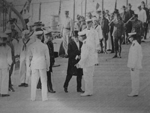 | 532k | Governor Oscar Branch Colquitt, of Texas Rangers fame, on board the Texas (BB-35) in 1914. | Photo courtesy of SK/3 Tommy Trampp. | |
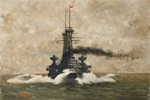 | 76k | Oil on canvas painting by the artist J.Lau entitled "Texas, circa pre WW I." Size in cm: 39 x 56, for sale, contact Asmund Agdestein. The painting depicts an American battleship (cage masts) with two curved roofed turrets in the No. 1 and No. 2 positions which were used only for the 14" gun turrets of the New York (BB-34/35), Oklahoma (BB-36/7) and Pennsylvania (BB-38/9) classes. Oklahoma class would have a 3-gun turret in the No. 1 position while the Pennsylvania class would have 3 guns in each turret. The painting seems to show only 2 guns per turret; this leave us with the New York class (BB-34/35): New York & Texas. It is a pre-WWI view. No evidence of a flying-off platform anywhere, and none of the wartime superstructure additions are present. If the stack bands are really on the second funnel (they look like they might have been crudely added to the photo after it was taken), the date would be about 1914. I would say with 95% certainty that the painting depicts the Texas. The smoke from the funnels obscures much detail of the mast structure but I can make out what should be to searchlights on the foremast mounted one above the other. This arrangement would mean the Texas. The New York carried her search lights on a single platform mounted side by side on both mast which in this painting would be visible projecting from the sides of the masts at about the same level as the 3" guns mentioned above. | Text i.d. courtesy of Chris Hoehn & Chuck Haberlein. Photo courtesy of Asmund Agdestein. | |
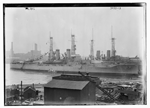 | 250k | Texas (BB-35) on 24 March 1914 with an unknown battleship moored alongside and the cage masts of another looming over the foreground. The "turtle-back" style of turret is particular to the New York, Oklahoma and Pennsylvania classes and of these only the New York class have 2 funnels. Ergo if Texas is in the foreground it must be New York (BB-34) on the other side. In pre-war photos the easy telltale for distinguishing between these two sisters is the searchlights mounted on the masts; Texas carries them one above the other and New York carries them on a single level. This arrangement changes on Texas immediately after the war. | Digital ID # ggbain 16025v, LC-B2-3055-13. Source: Library of Congress Prints and Photographs Division, from the George Grantham Bain Collection. Text i.d. courtesy of Chris Hoehn. | |
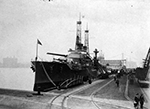 | 1.06k | Texas (BB-35) with her commissioning flag slightly bowed, the Texas is moored dockside on 24 March 1914. Note the trolley tracks alongside for the movement of cranes and the boarding ladder dockside. | Digital ID # ggbain 16026v, LC-B2-3055-14. Source: Library of Congress Prints and Photographs Division, from the George Grantham Bain Collection. | |
 013506a |
548k | March 1914 (mislabeled, based on my research and she has snow on her, it has be close to her commissioning of 24 March. I've seen photos of her on that date with snow) | Photo courtesy of gallica.bnf.fr via Daniel Hacker. | |
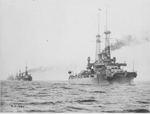 013228t | 739k | Battleships of the U.S. Atlantic Fleet steaming in column formation, circa 1914. The leading ship is either Wyoming (BB-32) or Arkansas (BB-33). Note the dense smoke produced by these coal-burning ships. The Texas (BB-35) is next in line. | Photographed by Enrique Muller, New York. National Archives Identifier: 55242096 Local Identifier: 111-SC-41485. Photo courtesy of catalog.archives.gov | |
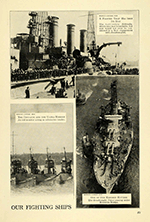 | 353k | A FIGHTER THAT HAS SEEN ITS DAY. The battleship Nebraska (BB-14), which once was formidable, but would now not even be considered in a fleet engagement with dreadnoughts. ONE OF OUR HARDEST HITERS The dreadnought Texas (BB-35) passing under Brooklyn Bridge. This is an original 1915 World War I halftone print of battleships and dreadnoughts, specially featuring the Nebraska and Texas. |
Photo courtesy of periodpaper.com | |
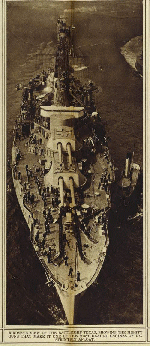 | 3.34k | Biggest of Our Battleships Passing Up the East River. "Birdseye view of the battleship Texas (BB-35), showing the mighty guns that make it one of the most deadly engines of destruction afloat." | Image and text provided by The New York Public Library, Astor, Lenox and Tilden Foundation. Insert PDF text courtesy of the The Evening World., (New York, N.Y.) 1887-1931, 27 March 1914, Final Edition, Image 2, courtesy of memory.loc.gov. Photo by International News Agency. Text courtesy from The War of the Nations (New York) N.Y. Times, 31 December 1919, Page 376, courtesy of memory.loc.gov. | |
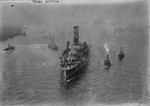 013525 |
1.71k | Texas (BB-35) proceeding down the river with a escort of tug boats, 27 March 1914. | Publisher Bain News Service. Reproduction Number: LC-DIG-ggbain-15656 Photo courtesy of loc.gov | |
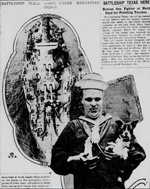 |
1.08k | BATTLESHIP TEXAS (BB-35) GOING UNDER MANHATTAN BRIDGE. Newest Sea Fighter at Navy Yard for Finishing Touches. YEOMAN LEAVING WITH THE BATTLESHIPS MASCOTS |
Image and text provided by Library of Congress, Washington, DC. Photo & text by New-York Tribune. (New York [N.Y.]) 1866-1924, 28 March 1914, Image 20, courtesy of chroniclingamerica.loc.gov. Insert photo # LC-B2-3055-12 & text from George Grantham Bain Collection (Library of Congress) via flickr.com. |
|
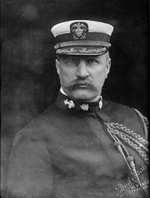 | 136k | Capt. Albert Weston Grant commanded the battleship Texas (BB-35) from March 1914 to September 1915. | Photo courtesy of the Library of Congress & submitted by Bill Gonyo. | |
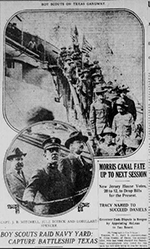 |
NR | BOY SCOUTS RAID NAVY YARD, CAPTURE BATTLESHIP TEXAS (BB-35) . |
Image and text provided by Library of Congress, Washington, DC. Photo & text by New-York Tribune. (New York [N.Y.]) 1866-1924, 07 April 1914, Image 6, courtesy of chroniclingamerica.loc.gov. |
|
| Veracruz Incident |
||||
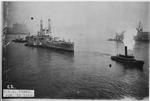 |
947k | Tugs of war: Battleship Texas (BB-35) being tugged 15 April 1914. | National Archives Identifier: 85702471 Local Identifier: 19-N-22 Photo courtesy of catalog.archives.gov via Daniel Hacker. | |
 | 727k | BATTLESHIPS TEXAS (BB-35) AND NEW YORK (BB-34) GETTING READY TO SAIL FOR MEXICO | Image and text provided by The New York Public Library, Astor, Lenox and Tilden Foundation. Photo from the The Evening World. (New York, N.Y.) 1887-1931, 15 April 1914, Final Night, Image 3, courtesy of chroniclingamerica.loc.gov. | |
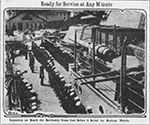 | 669k | Ready For Service At Any Minute Inspection on Board the Battleship Texas (BB-35) Just Before It Sailed For Mexican Waters. |
Image and text provided by University of Nebraska-Lincoln Libraries, Lincoln, NE. Photo from the Omaha Daily Bee. (Omaha [Neb.]) 187?-1922, 21 April 1914, EXTRA, Image 1, courtesy of chroniclingamerica.loc.gov. | |
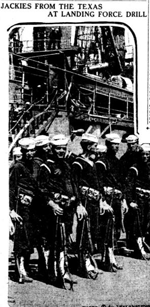 | 831k | JACKIES FROM THE TEXAS (BB-35) AT LANDING FORCE DRILL |
Image and text provided by Library of Congress, Washington, DC. Photo from the The Washington Herald.(Washington, D.C.) 1906-1939, 26 April 1914, Image 3, courtesy of chroniclingamerica.loc.gov. | 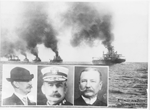 | 1.15k | U.S. Atlantic Fleet battleships steaming toward Mexican waters in 1914. Photograph copyrighted in 1914 by E. Muller, Jr., and Pach. The following battleships that were dispatched to Mexican waters included the: Ohio (BB-12), Virginia (BB-13), Nebraska (BB-14), Georgia (BB-15), New Jersey (BB-16), Rhode Island (BB-17), Connecticut (BB-18), Louisiana (BB-19), Vermont (BB-20), Kansas (BB-21), Minnesota (BB-22), Mississippi (BB-23), Idaho (BB-24), New Hampshire (BB-25), South Carolina (BB-26), Michigan (BB-27), Delaware (BB-28), North Dakota (BB-29), Florida (BB-30), Utah (BB-31), Wyoming (BB-32), Arkansas (BB-33), New York (BB-34) & Texas (BB-35). In insets are (left to right): Rear Admiral Henry T. Mayo, Rear Admiral Frank F. Fletcher, Rear Admiral Charles J. Badger. | Naval History and Heritage Command # NH 60322. |
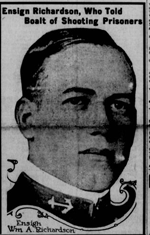 | NR | Boalt Tells the Story of His Trial by Naval Court Martial Aboard U. S. Battleship Texas (BB-35). | Image and text provided by Washington State Library; Olympia, WA. Photo from The Seattle Star. (Seattle, Wash.) 1899-1947, 22 July 1914, Image 1, via chroniclingamerica.loc.gov. |
|
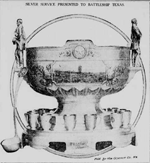 |
953k | SILVER SERVICE PRESENTED TO BATTLESHIP TEXAS (BB-35) School Children Galore at Presentation in Galveston of Elaborate Gift of People of State After Which Battleship Is Named | Image and text provided by Library of Congress, Washington, DC. Photo from New-York Tribune. (New York [N.Y.]) 1866-1924, 08 November 1914, Image 7, via chroniclingamerica.loc.gov. Inset photo courtesy of Scott Koen & ussnewyork.com. |
|
| Mid 19 Teens |
||||
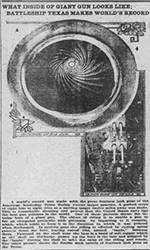 | NR | WHAT INSIDE OF GIANT GUN LOOKS LIKE; BATTLESHIP TEXAS (BB-35) MAKES WORLD'S RECORD | Image and text provided by Connecticut State Library, Hartford, CT. Photo from the The Bridgeport Evening Farmer.(Bridgeport, Conn.) 1866-1917, 19 February 1915, Image 12, courtesy of chroniclingamerica.loc.gov. |
|
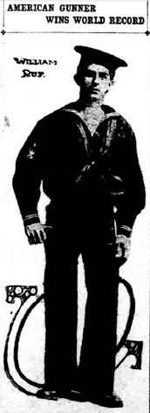 | NR | AMERICAN GUNNER WINS WORLD RECORD William Ruf, gun pointer on the battleship Texas (BB-35),on furlough home here, has received word from the Navy Department that he set a new world's record in big gun marksmanship off the Virginia Capes in recent practice. He scored eight straight hits with a 14-inch gun at a moving target twelve miles away. He receives a cash prize of $20 for this feat. |
Image and text provided by Library of Congress, Washington, DC. Photo from the The Washington Herald.(Washington, D.C.) 1906-1939, 21 February 1915, SOCIETY SECTION, Image 21, courtesy of chroniclingamerica.loc.gov. | |
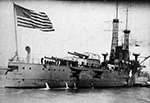 | 568k | Texas (BB-35) about to appear in the upcoming naval review four days before this date, 15 May 1915. | USN photo # Lot 10788-5, George C. Bain Collection, Courtesy of Library of Congress, from the National Museum of the U.S. Navy via flickr.com. | |
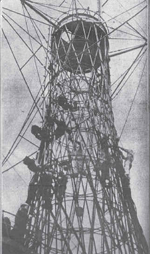 | 418k | DOLLING UP FOR THE BIG DAY. Painting the main fighting mast of the big Texas (BB-35) to make her ready for the review. |
Photo by Underwood & Underwood. Image and text provided by Penn State University Libraries; University Park, PA. Photo from Evening Public Ledger. (Philadelphia [Pa.]) 1914-1942, 11 May 1915, Night Extra, Image 16, via chroniclingamerica.loc.gov. |
|
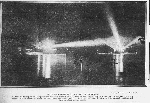 | 250k | OUTLINED AGAINST A CURTAIN OF DARKNESS A fleet of destroyers and torpedo-boats has now arrived at New York to join the heavy ships of the line. Altogether, about 50 vessels will be assembled when the ceremonies began next Monday. It is promised that the strained international relations will have no effect on the parade. | Photo by International News Service. Image and text provided by Penn State University Libraries; University Park, PA. Photo & text by Evening Public Ledger. (Philadelphia [Pa.]) 1914-1942, 13 May 1915, Night Extra, Image 16, courtesy of chroniclingamerica.loc.gov. | |
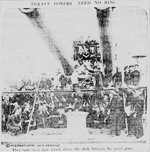 | 862k | TEXAS (BB-35) BOXERS NEED NO RING They spar on a spar raised above the deck between the great guns. |
Photo by International News Service Image provided by: Library of Congress, Washington, DC. Photo & text by New-York Tribune. (New York [N.Y.]) 1866-1924, 14 May 1915, Image 4, courtesy of chroniclingamerica.loc.gov. | |
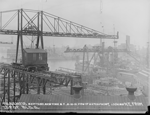 013915h | 3.84k | View of Waterfront, Looking Northeast from Top of Building 6, 15 June 1915. Who is in town for the launching of the Arizona (BB-39) (not seen)? Texas (BB-35) is the ship behind the crane at left based on the searchlight config. Wyoming (BB-32) is the ship on the right in the foreground (with the structure on her stern), based on searchlights and the cagemast tops, which puts Arkansas (BB-33), as the ship whose stern is visible just to port of Wyoming. New York (BB-34) is beyond Wyoming, in the background. | Photo I.D. courtesy of Richard M. Jensen. National Archives Identifier: 6281355 Agency-Assigned Identifier: F644 N218 Photo courtesy of catalog.archives.gov | |
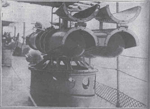 | NR | Torpedoes & tubes as mounted ready for action on board the Texas (BB-35). One of the sights which drew the fascinated gaze of visitors to the ships of the North Atlantic fleet, at New York, was the deck torpedo tubes of the dreadnought Texas. The Picture on the right above shows the bottom half of the hinged tubes, raised to show the deadly missiles lying in their resting places like larvae in a wasp's nest. The torpedoes are set in motion by compressed air, their course being kept true by means of compressed air from their propellers and gyroscopic attachments. On the left is a typical torpedo of the short, blunt type favored by the American Navy. It's probably a case of the reporter/editor cutting corners because they don't think any one knows better. While the Texas / New York were originally armed with 4 21" torpedo tubes mounted in pairs, port and starboard, they were not deck mounts but located in the hull below the water line roughly in line with the Nos. 3 & 4 5"/51 mounts. Notice the 2 ports in the side of the ship below, these as the torpedo tubes. It is possible that the other photo on the same page of the newspaper which shows a torpedo displayed on the deck of a ship might have been taken aboard the Texas but not certain. The torpedo tubes above are most probably photographed aboard a Cassin/Alwin class or O'Brien/Tucker class destroyer. |
Image provided by: Penn State University Libraries; University Park, PA. Photo from the Evening Public Ledger, (Philadelphia [Pa.]) 1914-1942, 18 May 1915, courtesy of chroniclingamerica.loc.gov. Text i.d. courtesy of Chris Hoehn. |
|
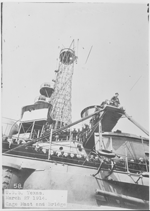 |
1.30k | Texas (BB-35) Cage Mast and Bridge, 27 March 1914. | National Archives Identifier: 85704337 Local Identifier: 19-N-58 Photo courtesy of catalog.archives.gov via Daniel Hacker. | |
 | 4.26k | "The Holland - America Liner Ryndam, settling low in the water after her collision with the Cuneo, convoyed by the battleship Texas (BB-35), from which this photo was taken." | Photo from Brown Bros. Text courtesy of N.Y. Times, 6 June 1915, Page 8, courtesy of memory.loc.gov. |
|
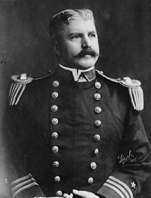 | 177k | Captain John Hood was the Commanding Officer of the battleship Texas (BB-35) in 1915-1916. During his command the Texas won the "Red E" for excellence in engineering efficiency. | Photo #15824v courtesy of the Library of Congress via Bill Gonyo. | |
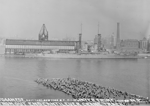 | 400k | Texas (BB-35) sports a pair of E's on her main turrets at the New York Navy Yard on 1 November 1915. | National Archives Identifier: 6281318 Photo courtesy of catalog.archives.gov | |
 | NR | TEXAS (BB-35) LEADS IN GUNNERY. The battleship Texas leads the navy in gunnery merit for the year 1915-16. Official figures give the Texas a mark of 93.7. The battleship Arkansas (BB-33), with a mark of 33.927, came last among the sixteen ships whose records were announced. The Texas and New York (BB-34) are the only ships carrying 14-inch rifles, the others all being armed with 12-inch main batteries. | Image and text provided by West Virginia University. Photo from the The Wheeling Intelligencer. [volume] (Wheeling, W. Va.) 1903-1961, 29 July 1916, Image 1, courtesy of chroniclingamerica.loc.gov. |
|
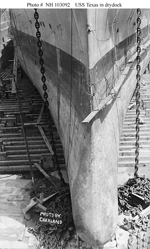 | 90k | Texas (BB-35) in drydock, with painting stages rigged along her waterline area. Anchors and chain are on the drydock floor. The image reverse is marked "circa 1916". Photographed by Charland. The original image is printed on postal card ("AZO") stock. | Naval History and Heritage Command photo # NH 103092, Donation of Dr. Mark Kulikowski, 2005. | |
 | 720k | Deck cleared for action, #4 turret Texas (BB-35), 1916. | USN photo courtesy of Pieter Bakels. | |
 | 878k | #1 & 2 turrets. | USN photo courtesy of Pieter Bakels. | |
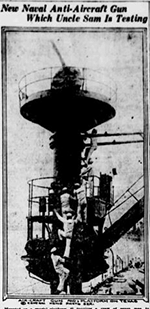 | 750k | New Naval Anti-Aircraft Gun Which Uncle Sam Is Testing | Image and text provided by The New York Public Library, Astor, Lenox and Tilden Foundation. Photo from the The Evening World. (New York, N.Y.) 1887-1931, 18 August 1916, Final Edition, Image 3, courtesy of chroniclingamerica.loc.gov. | |
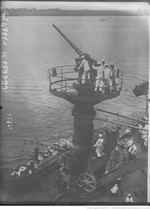 013516p |
842k | IN the present naval maneuvers, a three inch gun, mounted to give it a high degree of elevation, will be tried out aboard the United States battleship Texas (BB-35) for war on hostile aircraft. If the trials prove a success all warships in the navy will be equipped in similar manner. The rifle fires thirty shots a minute and requires a crew of seven men to operate it. The picture shows the gun and platform on the Texas. | Image and text provided by The New York Public Library, Astor, Lenox and Tilden Foundation. Photo from the The Sun.(New York, [N.Y.]) 1916-1920, 19 August 1916, Image 3, courtesy of chroniclingamerica.loc.gov. Photo courtesy of gallica.bnf.fr via Daniel Hacker. |
|
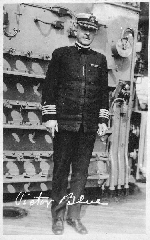 | 110k | Blue, New Commander of the Texas (BB-35), Won Fame In Spanish-American War. Captain Victor Blue, USN. He was the third commanding Officer of the Battleship Texas, from 14 August 1916 to 31 December 1918. Photo taken on board. | Image and text provided by Connecticut State Library, Hartford, CT. Photo from the The Bridgeport Evening Farmer. [volume] (Bridgeport, Conn.) 1866-1917, 17 August 1916, Image 6, courtesy of chroniclingamerica.loc.gov. USN photo courtesy of Robert M. Cieri. |
|
| Over There 1917 - 1919 |
||||
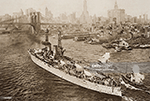 | 689k | Texas (BB-35) heads upriver towards the New York Navy Yard. Topmasts are down to allow passage under the Brooklyn Bridge. Notice 5"/51 caliber anti-destroyer gun mounted at her stern. This, along with all the other hull mounted guns, were eventually eliminated due to their closeness to the waterline. They were wet even in moderate seas. In this photo all 19 original hull guns are still present. The first removals were in October 1917, per the armament page of the ship's deck log. Even on builders trials she was carrying search lights on the king-post platforms which are empty in the photo. | Partial text and photo i.d. courtesy of Chuck Moore & Chris Hoehn. Photo by Universal History Archive/Getty Images courtesy of gettyimages.com. | |
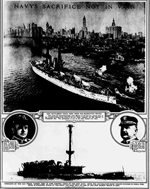 | 450k | NEW BATTLESHIP TEXAS (BB-35) SEEN PROM THE MANHATTAN BRIDGE. This 37,000 ton superdreadnought, most efficient of the first line, gained many of her records in firing at the wreck of the old Texas (renamed the San Marcos) in Chesapeake Bay. The photograph is one of the most unusual ever taken. REMNANTS OF THE OLD TEXAS, TARGET USED IN FIRE CONTROL TESTS OF THE NEW NAVY. NOTE THE OLD MILITARY MAST, THOUGH RIDDLED BY SHELL FIRE STILL IS STANDING, WHILE AT THE RIGHT THE BASE ONLY OF ONE OF THE NEW BASKET MASTS IS LEFT. | Photo by Enrique Mueller Jr. Image and text provided by The New York Public Library, Astor, Lenox and Tilden Foundation Photo by The Sun. (New York [N.Y.]) 1916-1920, 07 January 1917, Section 4 Pictorial Magazine, Image 47, courtesy of chroniclingamerica.loc.gov. |
|
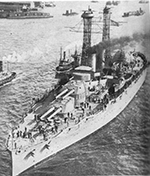 | 2.29k | Port side bow photo of the Texas (BB-35) circa 1917 in the East River, NYC. | USN photo scanned from The First World War at Sea: 1917 by Phil Carradice, courtesy Robert Hurst. | |
 |
3.05k | Texas (BB-35) circa 1917. | Photo copyright 1917 C.E. Waterman with another copyright O.W. Waterman, Hampton VA., courtesy of David A. Jones MMCM(SW) USN Retired. | |
 |
3.38k | Crew of the Texas (BB-35), circa 1917. | Photo copyright 1917 C.E. Waterman with another copyright O.W. Waterman, Hampton VA., courtesy of David A. Jones MMCM(SW) USN Retired. | |
 | 66k | THE DEFENSE OF NEW YORK The Texas (BB-35), one of our most powerful fighting ships. | Image and text provided by The New York Public Library, Astor, Lenox and Tilden Foundation. Photo from the The Sun.(New York, [N.Y.]) 1916-1920, 11 February 1917, Section 5 Special Feature Supplement, Image 45, courtesy of chroniclingamerica.loc.gov. | |
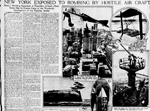 | 864k | NEW YORK EXPOSED TO BOMBING BY HOSTILE AIR CRAFT. Peary's Startling Statement of Possibility of Such a Raid Borne Out by Known Facts of the Wonderful Development of the Fighting Airship ONE OF OUR ALL TOO FEW ANTI-AIR CRAFT GUNS ABOARD THE BATTLESHIP TEXAS (BB-35) | Image and text provided by The New York Public Library, Astor, Lenox and Tilden Foundation. Photo from the The Sun.(New York, [N.Y.]) 1916-1920, 04 March 1917, Section 5 Special Feature Supplement, Image 49, courtesy of chroniclingamerica.loc.gov. | |
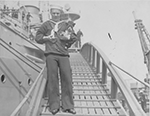 |
494k | Sailor of the Battleship Texas (BB-35) and mascots - two white mice and a dog, circa March 1917. | Photographer: West. Newspaper. Union National Archives Identifier: 45511029 Local Identifier: 165-WW-326D-9 Photo courtesy of catalog.archives.gov |
|
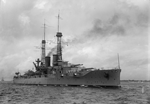 | 318k | The Texas (BB-35) with other Battleships of the Atlantic Fleet at Hampton Roads, 1917. Note only 2 guns on No. 1 Turret and the over/under arrangement of the searchlights. The photo is incorrectly listed in the LOC as the Nevada (BB-36). | Library of Congress photo # LC-DIG-hec-08102 courtesy of the Harris & Ewing Collection. Photo i.d. courtesy of Chris Hoehn. |
|
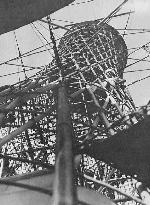 | 53k | Cage mast against the sky. | USN photo courtesy of Pieter Bakels. | |
 | 29k | Crewmen bend over shells for Texas (BB-35) main armament during her WW I service. | USN photo courtesy of Pieter Bakels. | |
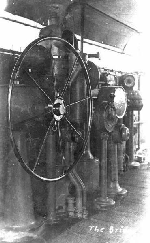 | 539k | The bridge. | USN photo courtesy of Pieter Bakels. | |
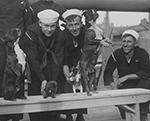 | 488k | The two dogs on the left, "Buster" and "Queenie," mascots of the Texas (BB-35), are acting as hosts to the mascots of New York (BB-34)....April 1917. | Photographer: Central News Photo Service. National Archives Identifier: 45511019 Local Identifier: 165-WW-326D-004. Photo courtesy of catalog.archives.gov |
|
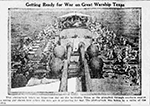 | NR | Getting Ready for War on Great Warship Texas (BB-35). This photograph taken on Inspection day on the battleship Texas as she ploughed through southern season a spring day shows how active the men are in preparing for war. The photograph was taken by a sailor of the ship. | Image and text provided by University of New Mexico. Photo from the Albuquerque Morning Journal. (Albuquerque, N.M.) 1903-1926, 01 June 1917, CITY EDITION, Editorial Section, Image 10, courtesy of chroniclingamerica.loc.gov. | |
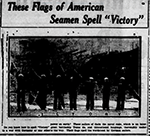 | 602k | These flags of American Seamen Spell "Victory" | Image and text provided by University of Oregon Libraries; Eugene, OR. Photo from the The Evening Herald. (Klamath Falls, Or.) 1906-1942, 02 June 1917, Image 2, courtesy of chroniclingamerica.loc.gov. |
|
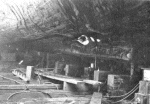 | 539k | Hull of Texas (BB-35) shown in dry-dock at New York Navy Yard. The Texas ran aground at Block Island on 27 September 1917. | USN photo contributed by Mike Green, courtesy of Leeward Publications. | |
 | 580k | Photo of the Texas (BB-35) getting ready to go "over there". Photo i.d. is based on the removal of the 2 large vent hatches in the roof of main battery turrets. I located an over head photo of the Texas in 1919 showing the patch in place of these vents on the No. 3 turrets and a couple photos of the fly-off platform on both No. 2 and No. 4 turrets showing it built too close to the Turret roof to allow clearance for the hatch. Additionally numerous photos of the New York (BB-34) including one just prior to her entering the Navy Yard for the 1925 refit showing these hatches still in use (open). I suspect this modification occurred just prior to departing for England in 1917. The Texas ran aground off Block Island (in Long Island Sound) requiring her to return to the New York Navy Yard for repairs to her hull, delaying her arrival in England till December. As she was laid up the US Navy may taken the opportunity to make additional modifications to her, based on recommendations by the Royal Navy inspection of the ships to be sent to England, that would have delayed the departure of the fleet too long if they had been made on all the ships. As it was the only modifications made to most ships was to remove some of the secondary battery (generally the most forward), add 2 guns for AA defense and to add an enclosed navigation bridge. | Photo courtesy of Dorothy Deina Porter. Text i.d. courtesy of Chris Hoehn. | |
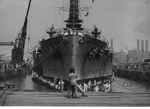 013508a |
179k | In August 1917, Texas (BB-35) steamed to New York for repairs, arriving at Base 10 on the 19th and entering the New York Navy Yard soon thereafter. She completed repairs on 26 September and got underway for Port Jefferson that same day. During the mid-watch on the 27th, however, she ran hard aground on Block Island. For three days, her crew lightened ship to no avail. On the 30th, tugs came to her assistance, and she finally backed clear. Hull damaged dictated a return to the yard, and the extensive repairs she required precluded her departure with Division 9 for the British Isles in November. By December, she had completed repairs and moved south to conduct war games out of the York River. Mid-January 1918 found the battleship back at New York preparing for the voyage across the Atlantic. She departed New York on 30 January; arrived at Scapa Flow in the Orkney Islands off the coast of Scotland on 11 February; and rejoined Division 9, by then known as the 6th Battle Squadron of Britain's Grand Fleet. Texas appears here in drydock at the Brooklyn Navy Yard, ca. 1918. | Text courtesy of DANFS. Photo by Burnell Poole, courtesy of the family of Burnell Poole via maritimehistorian.wordpress.com | |
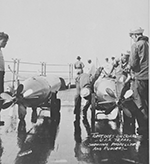 |
494k | Torpedoes aboard the Texas (BB-35) showing propellers and rudders. | Photographer: Kadell & Herbert. National Archives Identifier: 45514065 Local Identifier: 165-WW-339C-43 Photo courtesy of catalog.archives.gov |
|
 | 229k | "Superdreadnoughts of the United States Navy" This is an original 1917 sepia rotogravure by Bernard Poole showing America's super dreadnoughts during World War I. Battleships of the Sixth Battle Squadron included the: Delaware (BB-28), Florida (BB-30), Utah (BB-31), Wyoming (BB-32), Arkansas (BB-33), New York (BB-34), Texas (BB-35) & Arizona (BB-39) at one time or another. | Photo courtesy of periodpaper.com | |
 | 199k | This rare oil painting by American artist Burnell Poole, "The 6th Battle Squadron of the Grand Fleet Leaving the Firth of Forth", is one of less than two dozen paintings owned by the Navy that depicts U.S. naval operations in World War One (WWI). After years of being considered a total loss by Navy Art Gallery curators it has been restored to near perfect condition. The entire process took several months, but the result is the total recovery of a painting that is sure to establish Burnell Poole's name among the best marine painters of the early 20th century. The composition of the ships of the 6th Battle Squadron during their operational history, appearing in the painting in no particular order were: Delaware (BB-28), Florida (BB-30),Wyoming (BB-32), Arkansas (BB-33), New York (BB-34), & Texas (BB-35). | Photo and partial text courtesy of Naval Historical Center, Washington, D.C., File photo # N-0000X-001. Image and text provided by Library of Congress, Washington, DC. Photo from New-York Tribune. (New York [N.Y.]) 1866-1924, 09 June 1918, Image 36, via chroniclingamerica.loc.gov. |
|
 013224p |
NR | FIVE FIGHTING FLOATING FORTRESSES. A painting by Burnell Poole of the Sixth Battle Squadron of Britian's Grand Fleet, the American battleship division cooperating with the British Navy during the World War, which is to be presented to the British Admiriality at an early date by AdmiralHugh Rodman and the officers & men of his squadron. The ships in line are: New York (BB-34), Texas (BB-35), Wyoming (BB-32), Florida (BB-30) and Delaware (BB-28). |
Image and text provided by University of Nebraska-Lincoln Libraries, Lincoln, NE. Photo by The Omaha Morning Bee. [volume] (Omaha [Neb.]) 1922-1927, 03 February 1924, CITY EDITION, ALCOGRAVURE SECTION, Image 42, courtesy of chroniclingamerica.loc.gov. | |
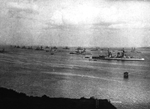 |
684k | Royal Navy (British) during the First World War. Royal Navy and U.S. Fleets at Rosyth, Scotland, 1917. HMS Lion, HMS Inflexible, HMS Indomitable, and the light battle cruiser squadrons with the U.S. Sixth Division behind. | USN photo # Lot 9609-39 from the National Museum of the U.S. Navy, courtesy of flickr.com. | |
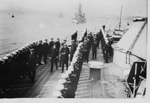 013518r | 1.15k | Franklin D. Roosevelt & Admiral of the Fleet Hugh Rodman stroll on the Texas (BB-35) off Scotland, 29 August 1918. | National Archives Identifier: 196067460. Local Identifier: 47-96:671 Photo courtesy of catalog.archives.gov, via Daniel Hacker. | |
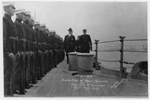 01a030s | 739k | Franklin D. Roosevelt Inspecting Marines on the Texas (BB-35), 29 August 1918. | National Archives Identifier: 196067446 Local Identifier: 42-192:238. Photo courtesy of catalog.archives.gov | |
 | 59k | The Texas (BB-35) in 1918, line painting by A.L. Raven. The date is close to November 1918 (for the Pilot House is present) but Texas did not have 3 inch guns atop turret 3, turret 4 and on the superstructure until August 1921. The enclosed torpedo defense platform on the mainmast (the structure below the searchlight platform) was not installed until late 1919 to 1920, as was the foremast. The present hull guns forward were removed in November 1918 and the present middle casemate guns were removed in October 1917. The airplane platform atop Turret 2 should be present for it was installed at the same time as the enclosed Pilot House. | From U.S. Battleships: An Illustrated Design History by Norman Friedman. Partial text and photo i.d. courtesy of Chuck Moore. | |
 | 382k | 21 November 1918 - U.S. battleships witness surrender of German High Seas fleet at Rosyth, Firth of Forth, Scotland, to U.S. and British fleets. New York (BB-34), Arkansas (BB-33), Delaware (BB-28), Texas (BB-35), Florida (BB-30), and Wyoming (BB-32). | Text & USN photo courtesy of Pacific Battleship Center - Battleship USS Iowa via Ron Reeves (of blessed memory). Photo i.d. courtesy of Andy McIntosh. | |
 013524h | 181k | Texas (BB-35) flying her battle flags at war's end. | Photo courtesy of William Garnett via his grand father Ernest Bloom, was on the Texas from 1914 to 1920. He was a CTC (Chief Turret Captain). | |
 013598 | 567k | CHALLENGE CUP photo op. Admiral Hugh Rodman is 2nd from left, Admiral Beatty is 2nd from the right. | Photo courtesy of William Garnett via his grand father Ernest Bloom, was on the Texas from 1914 to 1920. He was a CTC (Chief Turret Captain). | |
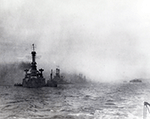 | 72k | Battleships of the Sixth Battle Squadron (anchored in column in the left half of the photograph): included the Florida (BB-30) Utah (BB-31) Wyoming (BB-32) Arkansas (BB-33) New York (BB-34) Texas (BB-35) & at one time or another. There are only three of the battleships present in this photo at Brest, France, on 13 December 1918. George Washington (ID-3018), which had just carried President Woodrow Wilson from the United States to France, is in the right background. Photographed by Zimmer | Naval History and Heritage Command # NH 63454. | |
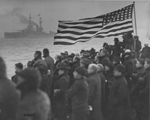 013591 | 1.08k | New York Welcomes Men of the Victorious Overseas Battleship Fleet BLUEJACKETS FROM THE ARKANSAS (BB-33) SWINGING DOWN FIFTH AVENUE, BOY SCOUTS MEANWHILE SINGING ROLLICKING MARCHING SONGS SECRETARY OF WAR, NEWTON D BAKER, in the Official Reviewing Stand, Receiving a Cup of Hot Coffee from Mrs. Julian M. Gerard, Secretary Daniels of the Navy, Served First THE HUGE FLORIDA (BB-30) CROWDING AND SHOULDERING HER WAY INTO NEW YORK HARBOR WATERS IN THE WINTER'S FIRST SNOW STORM THE ARIZONA (BB-39) LEADING THE RETURNING HOME OVERSEAS FLEET INTO NEW YORK HARBOR THROUGH A SNOW STORM AND HALF-A-GALE THE NEW YORK (BB-34), REAR ADMIRAL HUGH RODMAN'S FLAGSHIP of the Overseas Fleet,...on Entering New York Harbor, Firing a Salute in Honor of the Secretary of War. A "BLIMP" OF THE ATLANTIC FLEET SWINGING AT ANCHOR ABOVE THE MOTHER SHIP IN THE HUDSON THE HOME COMING FLEET Crowds watching the HOME COMING FLEET from the Press Boat. The Florida (BB-30) passing. For years I thought this was in fact what the press says. Thanks to Daniel Hacker submitting this photo, we can now see it is the Texas (BB-35). Note the airplane flyofff platform atop turret (installed 20 October - 4 November 1918). | Text & photo courtesy of Times Photo Service, N.Y. Times, 5 January 1919, Page 6, courtesy of memory.loc.gov. Photo by Paul Thompson. National Archives Identifier: 86697119. Local Identifier: 111-SC-45455. Photo courtesy of catalog.archives.gov via Daniel Hacker & i.d. by Richard M. Jensen. BB-35 info Image and text provided by Library of Congress, Washington, DC. & New-York Tribune. (New York [N.Y.]) 1866-1924, 18 November 1922, Image 8, via chroniclingamerica.loc.gov. | |
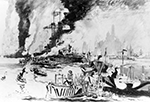 | 927k | Artist: H. Reuterdahl. Return of the Sixth Fleet Battle Squadron". Artwork shows the fleet arriving at New York City, New York. Battleships of the Sixth Battle Squadron included the: Delaware (BB-28), Florida (BB-30), Utah (BB-31), Wyoming (BB-32), Arkansas (BB-33), New York (BB-34) & Texas (BB-35) at one time or another. | NHHC Photograph Collection: NR&L 13322 from the National Museum of the U.S. Navy, courtesy of flickr.com. | |
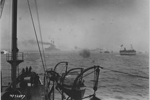 013593 |
845k | Return of the Victory Fleet: Enter Texas (BB-35). | Photo by Sgt. Palumbo. National Archives Identifier: 55224946 Local Identifier: 111-SC-32897 Photo courtesy of catalog.archives.gov | |
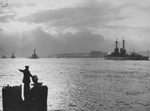 013595 |
1.42k | At sundown showing the Battleships at anchor in the Hudson River. The Texas (BB-35) appears on the right. | Photo by International Film Service National Archives Identifier: 45513399 Local Identifier: 165-WW-337D-047 Photo courtesy of catalog.archives.gov | |
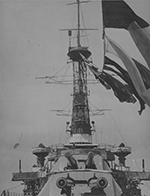 |
601k | VICTORY FLEET WELCOMED HOME The forecastle of the Texas (BB-35) of the Victory Fleet as she steamed up the Hudson River. | National Archives Identifier: 45513338 Local Identifier: 165-WW-337D-17. Photo courtesy of catalog.archives.gov | |
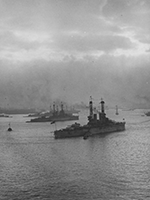 | 651k | Victory fleet in Hudson River: It appears that New York (BB-34) is in the foreground & Texas (BB-35) in the background. | Photo i.d. & text courtesy of Richard M. Jensen. National Archives Identifier: 45513330 Local Identifier: 165-WW-337D-13. Photo courtesy of catalog.archives.gov | |
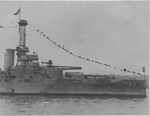 013585 | 1.08k | U.S. VICTORY FLEET WELCOMED HOME BY MIGHTY THRONGS Two views of Hydroplane mounted on the turret of the Texas (BB-35) of the Victory Fleet as she lay in the Hudson River, December 1918. |
Photo i.d. via Daniel Hacker. Photographer: Kadel & Herbert. National Archives Identifier: 45513354 & (Insert) 55246414 Local Identifier: 165-WW-337D-25 & (Insert) 111-SC-43778. Photo courtesy of catalog.archives.gov & Insert | |
 |
643k | Original Caption: VICTORY FLEET ARRIVES IN NEW YORK TWENTY FOUR HOURS AHEAD OF ITS SCHEDULE The big American fleet from Europe arrived in New York. One hundred and three war vessels were anchored in the Hudson River. Shows the battleship New York (BB-34). Unfortunately for the City of New York, the battleship is Texas (BB-35). Note the airplanes mounted fore & aft on the top turrets. | Photo i.d. & partial text courtesy of Richard M. Jensen. National Archives Identifier: 45513382 Local Identifier: 165-WW-337D-039. Photo courtesy of catalog.archives.gov | |
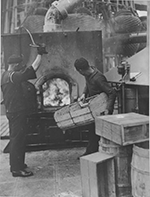 |
498k | One of the furnaces onboard the Texas (BB-35) being fed. Now that the ships are going back to pre-war conditions, a general clean-up is being made on the ships that came back with the Atlantic fleet. This photo shows the results of a clean-up on board the Texas | National Archives Identifier: 45512643 Local Identifier: 165-WW-334A-83. Photo courtesy of catalog.archives.gov | |
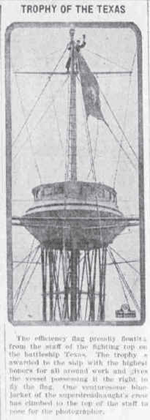 | NR | TROPHY OF THE TEXAS (BB-35). The efficiency flag proudly floats from the staff of the fighting top on the battleship Texas. The trophy is awarded to the ship with the highest honors for all around work and gives the vessel possessing it the right to fly the flag. One venturesome blue-Jacket of the super dreadnought's crew has climbed to the top of the staff to pose for the photographer. | Image and text provided by University of Nebraska-Lincoln Libraries, Lincoln, NE. Photo & text by The North Platte semi-weekly Tribune. (North Platte, Neb.) 1895-1922, 31 January 1919, Image 6, courtesy of chroniclingamerica.loc.gov. | |
 013580a | 1.41k | The Fleet in Guantanamo Bay, Cuba', circa 1919. The US Atlantic Fleet at Guantanamo Bay Naval Base in Cuba. They appear to be Texas (BB-35) at left, then New York (BB-34), with (probably) Arkansas (BB-33) more distant to the right. But the photo is not clear enough to confirm Arkansas. Behind the Texas is a 3 funneled Maine/Virginia or Connecticut class battleship. |
Photo & text i.d. via Richard M. Jensen. Photo by The Print Collector/Getty Images, courtesy of gettyimages.com. |
|
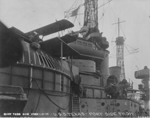 013582n |
636k | Texas (BB-35) port side from main deck. Navy Yard, New York. | National Archives Identifier: 496081317 Local Identifier: 19-N-1456 Photo courtesy of catalog.archives.gov |
|
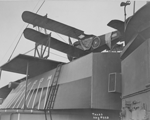 013514x |
626k | Turret and arrangement of airplane platform. Navy Yard, New York, 21 January 1919. | National Archives Identifier: 496081315 Local Identifier: 19-N-559 Photo courtesy of catalog.archives.gov | |
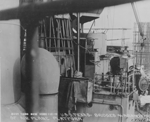 013514y |
3.29k | Bridges and arrangement of airplane platform. Navy Yard, New York, 21 January 1919. | National Archives Identifier: 496081313 Local Identifier: 19-N-1455 Photo courtesy of catalog.archives.gov | |
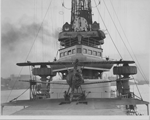 013514z |
3.03k | Sopwith Camel on the forward turret of Texas (BB-35) 1919. Note ship's bridge, rangefinder and range clock; anti-splinter mattresses around cranes on each side. | Photo text via John Spivey. National Archives Identifier: 496081311 Local Identifier: 19-N-557 Photo courtesy of catalog.archives.gov | |
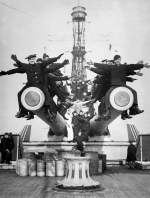 | 524k | "Gobs" and Guns. A scene aboard the Texas (BB-35), just back from foreign waters, showing the "gobs" enjoying a little fun on the big guns. | Photo by Underwood & Underwood, circa 1919. NARA FILE #: 165-WW-332D-43. Photo # HD-SN-99-02128 & text courtesy of dodmedia.osd.mil, Defense Visual Information Center. | |
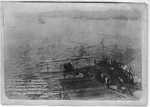 | 93k | First flight of airplane off an American battleship, by Lt. Connor McDonnell off Texas (BB-35) on 10 March 1919. | USN photo & text courtesy of Chris Hoehn via Chuck Moore. | |
 | 267k | Texas (BB-35) at sea in 1919; many biplanes overhead provided by the Bunnell Photo Shop, San Diego, Ca. | LOC photo # LC-USZ62-58097 / 3b05912r and text provided by Library of Congress, Washington, DC. | |
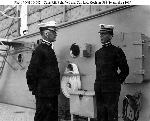 | 65k | Captain Frank H. Schofield, USN, Commanding Officer, Texas (BB-35), at left, on board his ship, circa July 1919, with his Executive Officer, Commander Ralph A. Koch, USN. Note the fire hose on the bulkhead between them. | Naval History and Heritage Command # NH NH 104942. Collection of Commander Haines H. Lippincott, USN (ChC). | |
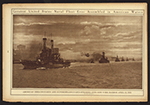 | 1.78k | "American dreadnoughts & super-dreadnoughts steaming into New York harbor 14 April 1919." The Texas (BB-35) leads the procession with a airplane on her turret catapult. Note the escorting biplane. The "escorting" aircraft is either a Curtiss HS-1 or HS-2 (note the single engine) can't tell which from the photo. The aircraft on a fly-off platform atop the No. 2 turret of the Texas is 1 of 6 Sopwith Camels purchased from Britain at the end of the war. The platforms were a British concept designed to provide the fleet with an aircraft capable of reaching the high flying Zeppelins which the German Navy occasionally used as scouts. The Texas was the only US Battleship to be fitted with turret fly-off platforms while in Europe and was the test bed for this program in the US Navy. Not visible in this view is a stripped down (No fabric and no wings) Sopwith 1-1/2 Strutter lashed atop the No. 3 Turret. The platforms were eventually mounted on all 14" gun BB's through the New Mexico (BB-40 / 42) class (with mixed reviews from their commanders) and carried either a Hanriot HD-1 or a Nieuport' 28. Though equipped inflatable floats for water landings, this tended to do a lot of damage not the least of which was dowsing a hot engine in cold salt water. By 1920 a successful compressed air catapult was developed and were being mounted on the aft deck of all 4 turreted battleships and fly-off platforms were removed. The Texas and New York (BB-34), because of their 5 Turrets, lacked the deck space for the catapult and had to make do with a float plane (Vought VE-7) sitting on the aft deck which would be launched by lowering it over the side for a surface take-off. If you look carefully at the photo you see the VE-7 on the deck and the A-frame hoist used for handling it. | Photo by Paul Thompson. Text courtesy of N.Y. Times, page 481, from The War of the Nations (New York), 31 December 1919, courtesy of memory.loc.gov. Text i.d. courtesy of Chris Hoehn. |
|
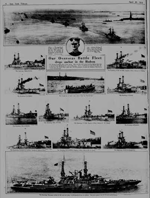 | NR | How the Atlantic Fleet looked to the camera man in a seaplane flying over lower Manhattan a week ago yesterday morning as the mighty armada came up the bay to anchorage in the Hudson off Riverside Drive for a two weeks' vacation after months of strenuous maneuvers in Southern waters. The destroyers Dale (DD-290) and Flusser (DD-289) are shown leading the column of eight dreadnoughts: Oklahoma (BB-37), Nevada (BB-36), Arizona (BB-39), flagship Pennsylvania (BB-38), Utah (BB-31), Florida (BB-30), North Dakota (BB-29) and Delaware (BB-28) past the Statue of Liberty at a fifteen-knot clip. In addition to the big battleships, the fleet includes thirty-two destroyers, numerous supply ships and several submarines. The Atlantic battleship fleet is home again. Here are the twelve great first line fighting ships that are paying Father Knickerbocker a two weeks' visit. Over a hundred of Uncle Sam's grim sea warriors gray the North River, while their 30,000 sailor-men are given the freedom of the city in a royal welcome home. The Battleship Mississippi (BB-41) leading the fleet into the harbor, as photographed from an airplane. Note the airplanes atop the forward and aft turrets. | Image provided by: Library of Congress, Washington, DC. Photo & text by New-York Tribune. (New York [N.Y.]) 1866-1924, 20 April 1919, Image 48, courtesy of chroniclingamerica.loc.gov. | |
 | 260k | Hanriot HD-1 tied down on the fly-off platform on the No. 2 Turret of the Texas (BB-35), circa 1919. | Photo courtesy of Chris Hoehn. | |
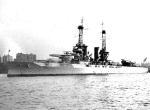 | 62k | Texas (BB-35) off New York City, circa 1919. Note plane on platform over #2 turret. Another, disassembled, plane is on the #3 turret. | Official USN photo Naval History and Heritage Command # NH 60339, now in the collections of the National Archives. | |
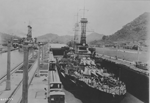 013513u | 830k | U.S. BATTLESHIPS PASSING THROUGH THE PANAMA CANAL Texas (BB-35) (left) and New York (BB-34) (right) in the locks of the Panama Canal, on 25 July 1919. Note the Hanriot HD-1 tied down on the fly-off platform on the No. 2 Turret of the Texas. |
Text i.d. via Daniel Hacker National Archives Identifier: 86738866. Local Identifier: 111-SC-67379 Photo courtesy of catalog.archives.gov | |
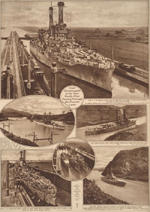 | 3.90k | Giant Dreadnoughts of the New Pacific Fleet through Panama Canal. The Texas (BB-35) transiting through Gatun Locks on 25 July 1919. Pictured also are the New Mexico (BB-40), New York (BB-34) & Arkansas (BB-33). | Photo by Times Wide World Service, & text courtesy of N.Y. Times, 17 August 1919, Page 2, courtesy of memory.loc.gov. | |
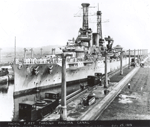 | 663k | Pacific Fleet through Panama Canal. The Texas (BB-35) transiting through Gatun Locks on 25 July 1919. Note aircraft on top of the #2 turret. | USN photo courtesy of Scott Koen & ussnewyork.com. | |
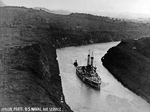 013519p | 703k | Texas (BB-35) in the Panama Canal on 25 July 1919. | Image scanned from a negative. Image is also NH 69228 via Darryl L. Baker. | |
 | 118k | A stationary Texas (BB-35) keeping her boilers burning as she stands anchored as a member of the Pacific Fleet, probably at San Diego, her home port, circa 1919. When the Texas & New York were designed and constructed, the U.S. Navy still held to the notion that a commanding officer was better able to con his ship if he were in touch with the elements, thus most warships of this era were constructed with open air navigation bridges (the last vestiges of the era of sail). On the New York class this platform was situated behind and about 4 feet below the roof level of the conning tower. To afford some protection form the elements it is usually protected canvas wind breaks along the hand rails and an awning overhead. Both of the photos in question show this arrangement. Upon the U.S. entering WW I, the Royal Navy sent a team of officers "across the pond" to inspect the fleet we were sending over and offer suggestions that would better enable the American ships to operate along side the Royal Navy. Among the suggestions offered was the construction of enclosed pilot houses capable of withstanding the pounding of the heavy seas of the northern latitudes and afford protection from the cold winter temperatures and sea spray. Therefore in 1917 all battleships sent to the war zone were fitted with such a structure. On the New York and Texas the pilot house was attached to the forward cage mast at a level above the roof of the conning tower. Both of the photos show the original navigation bridge arrangement therefore they have to have been taken prior to 1917 and thus they can not have been taken on the west coast. Of course the problem with sister ships is how to tell one from the other. In the case of the Texas and the New York during the pre-WW I time period (1914-1917), the best tell tale is the arrangement of the searchlights on the masts. The Texas carried her searchlights on individual platforms mounted one above the other about half way up the foremast and below the level of the funnels (and thus the smoke) on the main mast. The New York carried her searchlights side by side on a single platform about a third of the way up the foremast and below the funnel tops on the main mast. Given that the photographs in question are from this time frame we see that the photo that N. Moser labeled Texas is in fact the New York and the photograph labeled New York is in the Texas. During her refit in 1917, the Texas's searchlights were rearranged to the same as the New York's but photos from 1917 to 1920 can be distinguished by the clearly visible pilot house and the fly-off platforms atop the Nos. 2 and 4 turrets. The presence of 3" AA guns atop the Nos. 3 and 4 turrets will date photos in the 1921-1925 time frame. | USN photo by N. Moser, from the collection of the Vallejo Naval and Historical Museum, courtesy of Darryl L. Baker. Text i.d. courtesy of Chris Hoehn. | |
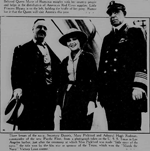 | 724k | Three bosses of the navy, Secretary Daniels, Mary Pickford and Admiral Hugh Rodman, commander of the new Pacific Fleet, from a photograph taken on the Texas (BB-35) in Los Angeles harbor, just after the ceremony at which Miss Pickford was made "little sister of the navy"; the title won by the film star as sponsor of the Texas, which won the "Match the Navy" Victory Loan contest. | Image and text provided by Library of Congress, Washington, DC. Photo from the New-York Tribune. (New York [N.Y.]) 1866-1924, 31 August 1919, Image 45, courtesy of chroniclingamerica.loc.gov. | |
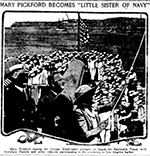 | NR | MARY PICKFORD BECOMES "LITTLE SISTER OF NAVY' Mary Pickford raising the George Washington pennant on board the Battleship Texas (BB-35), with Secretary Daniels and other officials participating in the ceremony in Los Angeles harbor. | Image and text provided by Library of Congress, Washington, DC. Photo from the The Washington Herald. (Washington, D.C.) 1906-1939, 19 September 1919, Image 2 courtesy of chroniclingamerica.loc.gov. | |
 | 37k | Hanriot HD-1 from the Texas (BB-35) on the beach. These markings appeared at a Fleet Review in November 1919 at Seattle WA in honor of a visit by President Wilson campaigning for approval of the League of Nations Treaty. | USN photo courtesy of Chris Hoehn via Chuck Moore. Text i.d. courtesy of Chris Hoehn. | |
| 1920s - Pre WW II |
||||
 | 905k | All hands enjoying California sunshine, 1918-22. | USN photo courtesy of Pieter Bakels. | |
 |
237k | Foreground is definitely Tennessee (BB-43). In the middle is Idaho (BB-42) (darker camouflage note also the fantail catapult) and upper right is Arizona (BB-39), less certain but based on main mast platforms verses the New Mexico (BB-40). Middle background is New York (BB-34) (navigation bridge not over hanging conning tower). The far left background is the Texas (BB-35) (blunt bow, 2 funnels). The aircraft is a Naval Aircraft Factory / Curtiss / Canadian Aeroplane Ltd F-5L. The date of Mr. Kreisman's photo has to be 1920-1921. By 1922 all 14" and 16" gunned BB's (except New York and Texas as the 5th turret did not leave enough deck space) had been fitted with a compressed air catapult on the stern. The presence of a stern A/C catapult on only one of the three 1916 program BB's suggest this early in the introduction of this equipment but late enough for the turret top fly-off platforms to have been removed from all ships present. In 1919 the Battle Fleet shifted its base to San Pedro in California where it remained based until shifted to Pearl Harbor. The Texas and New York were assigned to that fleet until they returned east for modernization in 1925. This would suggest that the photo was taken some where in the Pacific. The rich flora onshore suggest a tropical climate and the enclosed by would lead me to guess Panama or Gitmo. If the 1920 or 1921 Fleet problem was conducted in Atlantic waters could explain an Atlantic based aircraft with a Pacific based Fleet. |
Photo courtesy of Lance Kreisman via Fabio Pen~a. Photo & text i.d. courtesy of Chris Hoehn, Alan Moore & Richard Jensen. Aircraft i.d. courtesy of Alan Moore via Larkins, William T. US Navy Aircraft 1921-1941/US Marine Corps Aircraft 1914-1959. [The image came from the USMC aircraft section, pg(9).] Atglen, PA: Schiffer Publishing, 1995. (originally published as US Marine Corps Aircraft 1914-1959, copyright 1959, and US Navy Aircraft 1921-1941, copyright 1961). | |
 | 578k | Man O War Row, Texas (BB-35), Arkansas (BB-33), Wyoming (BB-32) & New York (BB-34) at anchor, San Francisco harbor, Xmas 1920. | USN photo courtesy of Pieter Bakels. | |
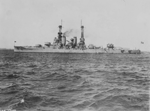 013502b |
1.08k | Back of Texas (BB-35) main batteries are visible in this unique photo, circa post 1920, actually. This compares well to some of her 1921 photos, so around that time, give or take a little. The flying off platform on turret 2 was added during her Grand Fleet period while the lookout stations on the two cagemasts were installed in the 1920-21 timeframe. | Text i.d. courtesy of Richard M. Jensen. National Archives Identifier: 496081319 Local Identifier: 19-N-8298 Photo courtesy of catalog.archives.gov | |
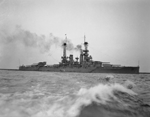 013569 |
1.27k | Texas (BB-35) circa January to August 1921. | Photo courtesy of digital.library.ucla.edu via Daniel Hacker. | |
 | 539k | 8 photo PDF of life aboard the Texas (BB-35), March / April 1921. | Photos courtesy of Tommy Trampp. | |
 | 670k | Texas (BB-35) underway with 6th Division, 16 April 1921. | USN photo courtesy of Pieter Bakels. | |
 |
56k | Texas (BB-35) watches Arkansas (BB-33) fire, 16 April 1921 with the Sixth Battleship Division out of San Pedro, CA. | USN photo courtesy of Robert M. Cieri. | |
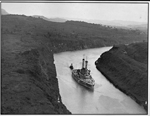 | 763k | Bow view of Texas (BB-35) underway in the Panama canal, circa 1919-21. | Photo i.d. courtesy of Richard M. Jensen. Lieutenant Thomas Marshall Colston Photograph Album. US Navy and Marine Corps Museum/Naval Aviation Museum, Photos No. 1986.094.001.030. | |
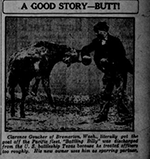 | 1.17k | A GOOD STORY-BUTT Clarence Goucher of Bremerton, Wash,, literally got the goat off the Pacific fleet. "Battling Billy" was discharged from the U. S. battleship Texas (BB-35) because he treated officers too roughly. His new owner uses him as sparring partner. | Image and text provided by Washington State Library; Olympia, WA. Photo from the The Seattle Star. (Seattle, Wash.) 1899-1947, 11 November 1921, Image 23, courtesy of chroniclingamerica.loc.gov. | |
 | 819k | Panoramic photo of the U.S. fleet in Panama Bay (Pacific entrance to the Panama Canal) on 1 March 1923. 70 vessels are viewed; the Battle Fleet consists of all U.S. battleships from the Delaware (BB-28) through the Idaho (BB-42). | Source: Library of Congress Prints and Photographs Division, courtesy of Tom Kermen. Copyright R.G. Lewis, Y Photo Shop, Balboa, C.Z." | |
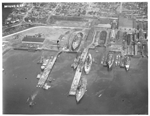 013416 | 609k | Two photographs of Puget Sound, Navy Yard, Bremerton, Washington, 21 August 1923. The nearest BB , bow on, is the Texas (BB-35), identified by her distinctive pilot house. New York (BB-34) is next, with all the awnings, and the Tennessee class ship in the drydock is most likely California (BB-44). At the time of the photos, Tennessee (BB-43) had a unique searchlight structure around the second stack which is not apparent here, but neither of the shots is clear enough to be absolutely certain. The 4 stacked partially canvassed ship at the end of the pier on the right is the Charleston (Cruiser No. 22). |
Photo i.d. courtesy of Chuck Haberlein & Richard M. Jensen. National Archives Identifier: 148728434 & 148728436 Local Identifier: 71-CA-428A-2 & 71-CA-428A-3 Photos courtesy of catalog.archives.gov & catalog.archives.gov | |
 | 525k | The United States fleet in Colon Harbor, Atlantic entrance to the Panama Canal, 21 January 1924. What appears to be the New York (BB-34) or the Texas (BB-35) is in the foreground. | Library of Congress photo # 6a24199r, from the Prints and Photographs Division, courtesy of Tom Kermen. Copyright R.G. Lewis, Y Photo Shop, Balboa, C.Z." | |
 | 29k | A snowy Texas (BB-35). The snowy scene of the No. 4 Turret shows the long base range finder mounted on the back of the turret and the 3"AA battery on the wing platforms were not added until 1922. These photos are probably all taken during the summer 1924 midshipman's cruise. | USN photo courtesy of Pieter Bakels. Text & i.d. courtesy of Chris Hoehn. | |
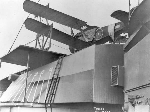 | 29k | Texas (BB-35) with a airplane on her turret catapult, circa early 1920's. | USN photo courtesy of Pieter Bakels. | |
 | 22k | Sighter takes aim and the crew prepare on a 5"/51 gun in warm and calm weather. | USN photo courtesy of Pieter Bakels. | |
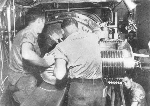 | 38k | Loading a 14" inch shell into the breech. | USN photo courtesy of Pieter Bakels. | |
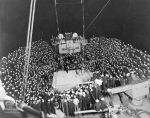 | 118k | Boxing match held on board during Battle Fleet maneuvers off Panama in 1923. View looks aft toward the rear of Turret # 4, which bears a banner reading "Texas (BB-35) ... Come On Texas ". Note Turret # 3 in the lower right, with a rangefinder and two 3"/50 anti-aircraft guns mounted on its top. | Naval History and Heritage Command # NH 55196, Photographed by Holtwick, now in the collections of the National Archives. | |
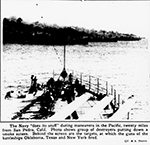 | 177k | The Navy "does its stuff" during maneuvers in the Pacific, twenty miles from San Pedro, Calif. Photo shows group of destroyers putting down a smoke screen. Behind the screen are the targets at which the guns of the battleships Oklahoma (BB-37), Texas (BB-35) and New York (BB-34) fired. | Image and text provided by Library of Congress, Washington, DC. via Evening Star. [volume] (Washington, D.C.) 1854-1972, 28 January 1923, Image 77, courtesy of chroniclingamerica.loc.gov. | |
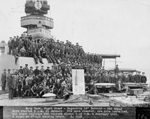 013522 |
1.33k | Re-gunning Texas (BB-35), Puget Sound Navy Yard, 6 February 1923. | Photo via Gary Mcintosh. | |
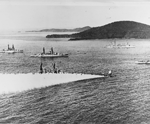 014508 |
1.69k | A naval scouting plane lays a protective smokescreen during maneuvers in the Caribbean Sea, 21 March 1924. Left to right: New York (BB-34/35) class battleship; Pennsylvania (BB-38/39) class battleship; Tennessee (BB-43/44) class battleship (behind smoke); Omaha (CL-4/13) class cruiser; Tennessee or Colorado (BB-45/48) class battleship (stern only visible). | Photo NH-69203 courtesy of history.navy.mil | |
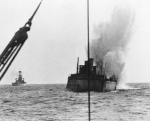 |
93k | A salvo from the battleship New York (BB-34) strikes the Washington (BB-47) on her starboard side while the ship was used as a target off Virginia Capes, Virginia, 26 November 1924. The battleship Texas (BB-35) is in the background. | USN photo courtesy of maritimequest.com. | |
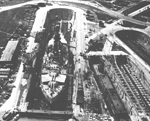 | 854k | The Texas (BB-35) in drydock about to begin modernization at Norfolk Navy Yard, 1925. Note the empty dock to her left; it would soon be occupied by her sister, New York (BB-34). | Photo i.d. courtesy of Chris Hoen. USN photo courtesy of Scott Koen & ussnewyork.com. |
|
 |
648k | New York (BB-34) & Texas (BB-35), April 1925, at Norfolk Navy Yard. | Photographer: Kadell & Herbert. National Archives Identifier: 52560683 Local Identifier: 181-V-7007 Photo courtesy of catalog.archives.gov |
|
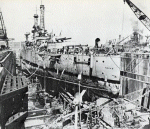 | 65k | Texas (BB-35) in drydock at Norfolk Navy Yard in 1925 as she began modernization. The ship on the right is the New York (BB-34), also undergoing modernization. | USN photo contributed by Mike Green, courtesy of Leeward Publications. | |
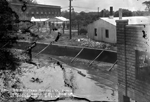 | 1.10k | U.S. Navy Yard, Norfolk, Va., 7-10-25. St. Helena Group of Buildings for Housing Crew of Texas (BB-35). | National Archives Identifier: 52560181 Local Identifier: 181-V-3127 Photo courtesy of catalog.archives.gov | |
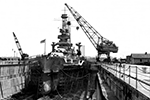 | 1.44k | Texas (BB-35) in dry dock at the Norfolk Naval Shipyard in Portsmouth, Virginia, circa 1926. | Photo i.d. courtesy of Richard M. Jensen. Photo from The Virginian-Pilot Photograph Collection / SMC Photograph Collection from the Norfolk Public Library (Va.) via Andrew Payne. | |
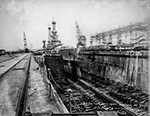 | 1.01k | Texas (BB-35) in Dry Dock #4, 29 March 1926. | National Archives Identifier: 52560335 Local Identifier: 181-V-3250. Photo courtesy of catalog.archives.gov |
|
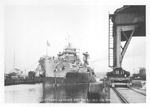 |
188k | Texas (BB-35) leaving drydock, 13 September 1926. | USN photo courtesy of Paul & Barbara Rebold. | |
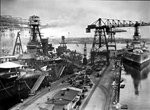 013513q |
695k | Texas (BB-35) & New York (BB-34) at the Norfolk Navy Yard, circa October 1926. Both ships were there for modernization and reconditioning of their power plants, with Texas further along in the process than New York. | Photo courtesy of marinersmuseum.org via Daniel Hacker. | |
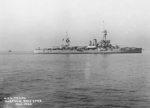 | 409k | Texas (BB-35) broadside without the bang; off Norfolk N.Y., in November 1926. | US National Archives photo # 19-lc-22a 4, from NARA, College Park, Maryland, courtesy of Sean Hert. | |
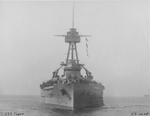 | 239k | Big size bow on view for a big size state. | US National Archives photo # 19-lc-22a 10628, from NARA, College Park, Maryland, courtesy of Sean Hert. | |
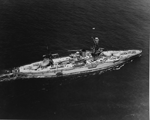 | 452k | Finished product for the end of the year: December 1926. | US National Archives photo # 19-lc-22 a 1, from NARA, College Park, Maryland, courtesy of Sean Hert. | |
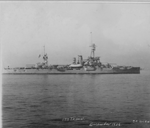 013528j |
Finished product for the end of the year: December 1926. | National Archives Identifier: 496081328 Local Identifier: 19-N-10625-A Photo courtesy of catalog.archives.gov | ||
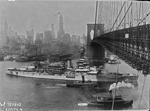 013515f | 1.06k | The battleship Texas (BB-35) takes to the sea as an up-to-the-minute seafighter after extensive reconditioning. She is shown here leaving New York Harbor to take her place as flagship of the United States fleet, after being equipped with the British style of tripod mast and other costly alterations. | Image and text provided by Library of Congress, Washington, DC. via Evening Star. [volume] (Washington, D.C.) 1854-1972, 18 September 1927, Image 96, courtesy of chroniclingamerica.loc.gov. Photo courtesy of gallica.bnf.fr via Daniel Hacker. |
|
 013527f | 437k | Texas (BB-35) was designated as USN flagship in September 1927. The PDF that appears here of the Flag Bridge was installed prior to the designation but after she left Norfolk dry dock, on 23 November 1926. The image is visible in the January 1928 entry into Havana Harbor. Note the admiral's flag flying from the foremast, searchlights grouped on the main mast and three Chance Vought O3U Corsairs mounted on the powder-type MK4 catapult atop #3 turret. The attached letters detail the origin of the alteration and record the approval. The 3 drawings included (007-009) are the sketches prepared by the ship and sent to Washington for review. The work took place at Norfolk NY in an availability that took from 6 June 1927 to 22 August 1927. The ship's last previous availability took place during 23 November to 4 December 1926. The ship's home yard was changed from Norfolk to New York effective 22 August 1927. There was a fire on board on about 29 August that put the ship back in yard hands--at New York--a few days later. The fire took place in cable insulation and was initially estimated to need about 50 man-days of repair work. Currently, though the flag bridge level is accessible to the public the flag plot is not open and the ports are plated over. An interesting and slightly related aside is that the navigation bridge below actual incorporate the original pilot house that was first added to the ship in 1917. In the overhead of the Captain's emergency cabin and the bridge radio space you can see where the plating ended in the curve of the old cage mast. The Navy Yard simply attached it to the new tripod mast and grafted on the after spaces. | USN photo courtesy Pieter Bakels. PDF insert photos & text courtesy of Chris Wright via Chuck Haberlein. Partial text courtesy of Chris Hoehn. PDF image and text provided by University of North Texas; Denton, TX. Photo from Brownsville Herald.[volume] (Brownsville, Tex.) 1910-current, 18 September 1927, SOCIETY, Image 16, via chroniclingamerica.loc.gov. |
|
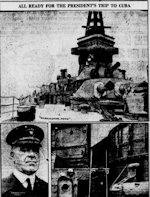 | NR | ALL READY FOR THE PRESIDENT'S TRIP TO CUBA. | A .P. Wirephoto Image and text provided by Library of Congress, Washington, DC. Photo & text by Evening Star. [volume] (Washington, D.C.) 1854-1972, 09 January 1928, Image 2, courtesy of chroniclingamerica.loc.gov. |
|
 | 502k | The square ports were installed in the wardroom for the President Coolidge's trip to Havana for the Pan American Comference in 1928. | Text & photo i.d. courtesy of Chris Hoehn. Photo possibly by Frank Lynch, chief photographer of the Seattle Post-Intelligencer, circa 1929. Photo from the collection of Carrie Schmidt. |
|
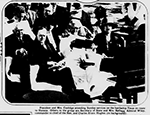 | NR | President and Mrs. Coolidge attending Sunday services on the battleship Texas (BB-35) en route to Havana. Others in the group are Secretary of State and Mrs. Kellogg. Admiral Wiley, commander-in-chief of the fleet, and Charles Evans Hughes (in background). They were attending the Pan-American conference. | Image and text provided by Library of Congress, Washington, DC. via Evening Star. [volume] (Washington, D.C.) 1854-1972, 22 January 1928, Image 89, courtesy of chroniclingamerica.loc.gov. | |
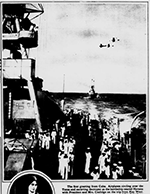 | NR | The first greeting from Cuba. Airplanes circling over the Texas (BB-35) and escorting destroyer as the battleship neared Havana with President Coolidge and Mrs. Coolidge on the trip from Key West. | Image and text provided by Library of Congress, Washington, DC. via Evening Star. [volume] (Washington, D.C.) 1854-1972, 29 January 1928, Image 117, courtesy of chroniclingamerica.loc.gov. | |
 | 98k | Texas (BB-35) entering Havana Harbor Cuba, 15 January 1928, carrying President Coolidge on board. | Photo courtesy of David Buell. | |
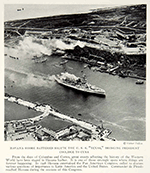 | 302k | Havana Shore Batteries Salute the Texas (BB-35) Bringing President Coolidge to Cuba. This is an original 1928 black and white halftone print of Havana batteries firing in salute of the arrival of the Texas. |
Photo courtesy of periodpaper.com | |
 | 570k | The battleship Texas (BB-35) entering Havana Harbor from Malecon ca. 1928. | Photo courtesy of Library of Congress, # LC-USZC4-14219 (Cropped) via Mike Green. | |
 013513j | 674k | US President Calvin Coolidge arrival in Havana for Pan American Conference, 15 January 1928 on board the Texas (BB-35). | Photo courtesy of meisterdrucke.uk | |
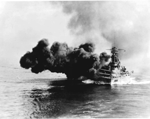 | 148k | Bow on view of Texas (BB-35) firing her 14"/45 main battery guns, during long range battle practice, February 1928. | From the Collection of Rear Admiral Ret. Jack Bowling, submitted by his grandson, Breck Perkins. | |
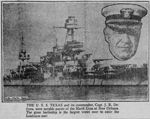 013513m | NR | THE TEXAS (BB-35) and its commander, Capt. J. R. Defrees, were notable guests of the Mardi Gras at New Orleans. The giant battleship is the largest vessel ever to enter the Louisiana port. | Image and text provided by Arizona State Library, Archives and Public Records; Phoenix, AZ. Photo from Nogales International.[volume] (Nogales, Ariz.) 1926-1979, 24 April 1928, Image 1 via chroniclingamerica.loc.gov. |
|
 | 30k | A Loening OL-6 on one of the catapults of the battleship Texas (BB-35) on June 1928. | USN photo courtesy of Pieter Bakels. | |
 | 258k | Texas (BB-35) looking pretty. The New York (BB-34) is astern of her. | Photo from Charles T. Wilder collection courtesy of David Way. | |
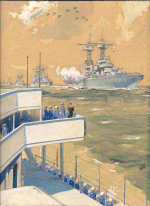 | 122k | Watercolor of a Presidential review during President Hoover's term of office, 1928-32. Crews line the rails of a Colorado class (BB-45 / 48) battleship as the ships pass in line astern of the reviewing stand with the airship Los Angeles (ZR-3) piercing the clouds accompanied by 9 biplanes. | Courtesy of Michael Schwarz. | |
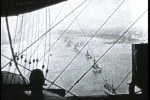 | 56k | View of the U.S. Battlefleet from above, possibly from the airship Los Angeles (ZR-3). | Photo courtesy of periscopefilm.com. | |
 | 717k | Texas (BB-35) Forecastle, 1929. | Photo courtesy of texashistory.unt.edu. via Daniel Hacker. | |
 013520b | 1.15k | During the February 1929 crossing to the West Coast, the aviation pioneer came aboard on the 6th, while docked in the Panama Canal Zone. The exact date is not known but a Time Magazine dated editorial of 6 February 1929 references an address Lindbergh made aboard Texas (BB-35) "the other night". The airplane shown here is a Vought O2U-1. The identification is based on the O2U-1 being the only airplane aboard Texas when Lindbergh was aboard. It is unknown if Lindbergh flew off of Texas in the airplane | Photo From BB35 veteran Dal Jines, 1929 to 1930 courtesy of battleshiptexas.info via Bob Canchola. | |
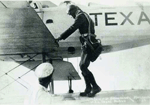 013520a | 557k | Charles A. Lindbergh, February 1929 aboard Texas (BB-35). | Photo courtesy of family of BB35 veteran Hans Kittle 1931 to 1934 battleshiptexas.info via Bob Canchola. | |
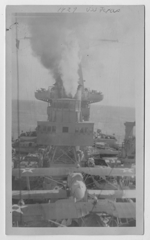 | 789k | Scout planes lined up between the masts, 1929. | Photo courtesy of texashistory.unt.edu. via Daniel Hacker. | |
 | 418k | Pilot house of Texas (BB-35). | Photo courtesy of texashistory.unt.edu. via Daniel Hacker. | |
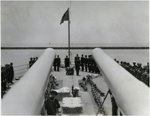 | 130k | "Best of luck to his boys". Admiral Henry A. Wiley, retiring at his own request after 47 years of service, falters in his farewell as he speaks a valedictory to his fellow officers and crew assembled on quarterdeck of the Texas (BB-35) off L. A. Harbor on 21 May 1929. He stands in the front of the line. | © Associated Press Photo courtesy of San Francisco Examiner via David S. Smith. | |
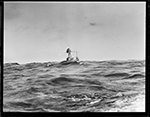 | 306k | Texas (BB-35) returned to New York early in 1929 for her annual overhaul and had completed it by March when she began another brief tour of duty in the Pacific. She returned to the Atlantic in June and resumed normal duty with the Scouting Fleet. Texas appears here off San Pedro, California plowing through heavy seas. | Text courtesy of DANFS. Photo 08_06_005544 courtesy of the Boston Public Library, Leslie Jones Collection. | |
 | 1.20k | Oil on canvas painting by the artist Tom Freeman entitled "A Texan in New York". The photo of the Texas (BB-35) on which the painting was inspired is shown here in the New York Navy Yard, 4 November 1930. | Photo and text courtesy of oldgloryprints.com Inset photo courtesy of Scott Koen & ussnewyork.com. | |
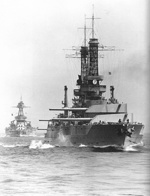 | 1.13k | Idaho (BB-42) (foreground) and Texas (BB-35). Steaming at the rear of the battle line, during Battle Fleet practice off the California coast, circa 1930. Idaho's four triple 14"/50 gun turrets are trained on the starboard beam. | Naval History and Heritage Command # NH 73834via Robert Hurst. | |
 | 385k | Texas (BB-35) in battle practice, 1931 - 34. | Photo courtesy of texashistory.unt.edu. via Daniel Hacker. | |
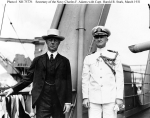 | 77k | Secretary of the Navy Charles Francis Adams (left),and Captain Harold R. Stark, USN, Aide to the Secretary of the Navy, on the signal bridge of Texas (BB-35), March 1931. Note leg of the ship's tripod foremast behind them. | Naval History and Heritage Command # NH 75776, now in the collections of the National Archives. | |
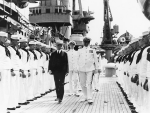 | 105k | Secretary of the Navy Charles Francis Adams inspects the crew of Texas (BB-35), March 1931. | Naval History and Heritage Command # NH 75775, now in the collections of the National Archives. | |
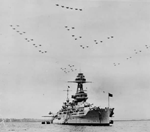 | 109k | Air cover of Texas (BB-35), 1932. | Photo courtesy of R. S. Rayfield, Jr., Maj. USMC (Retired). | |
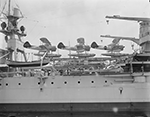 | 524k | Seaplanes on catapults aboard the Texas (BB-35) in the Charlestown Navy Yard, Boston, MA., 24 June 1934. | Photo 08_06_005583, courtesy of the Boston Public Library, Leslie Jones Collection, via digitalcommonwealth.org | |
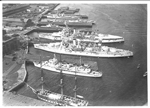 | 645k | The proper identification of the ships, top to bottom is: Farragut (DD-348), unidentified (possibly a buoy tender) (left) Lake class USCG cutter (either Modoc or Mojave) (right), Eagle 19, Texas (BB-35), New York (BB-34), French Navy aviso D'Entrecasteux, Constitution, in the Charlestown Navy Yard, Boston, MA., 24 June 1934. | Picture ID by Kate Monea, Archivist, USS Constitution Museum, USN photo from the Boston Public Library, Leslie Jones collection, courtesy of John Cross via Issac Davis & David Wright. | |
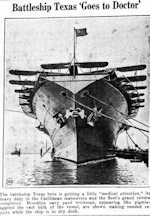 | NR | Good story, but wrong vessel. Battleship Texas (BB-35) 'Goes to Doctor.' The battleship Texas here is getting a little "medical attention," its heavy duty in the Caribbean maneuvers and the fleet's grand review completed. New York Navy Yard workman, appearing like pigmies against the vast bulk of the vessel, are shown making needed repairs while the ship is in dry dock. This is one of the Lexington class CVs. The photo is familiar, but I couldn't quickly locate it to tell whether this was CV-2 or CV-3. If this is Lexington, it is prior to 1936, when her forward flightdeck was widened. If Saratoga, it is prior to 1941 for the same reason. | Photo i.d. & text via Richard M. Jensen. Image and text provided by University of North Carolina at Chapel Hill Library, Chapel Hill, NC. Photo & text by The Times-News. (Hendersonville, N.C.) 1927-current, 28 June 1934, Image 8, courtesy of chroniclingamerica.loc.gov. | |
 | 55k | Commemorative post mark on the occasion of Thanksgiving day 1934 on the Texas (BB-35). | Courtesy of Jack Treutle (of blessed memory). | |
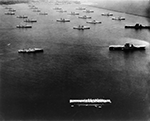 | 2.44k | Ships of the United States Fleet pictured at anchor inside the breakwater at Colon, Canal Zone, 1935. The carriers are, front to back, Langley (CV-1), Saratoga (CV-3) and Lexington (CV-2). The two battleships beyond Lexington are the New York (BB-34) with Texas (BB-35) behind. The nearest battleship, straight up from the Langley is Pennsylvania (BB-38). The BB immediately beyond and to the left of Pennsylvania (BB-38) is California (BB-44). The remaining battleships include two New Mexico's: Mississippi (BB-41) and Idaho (BB-42) , but even this higher rez shot is not clear enough to tell which is which. Also are the rest of the "Big Five" and what is probably one of the Nevada's, but that is not certain. The photo is not clear enough for positive identifications. The cruisers to the left are three Northampton's (CA-26 / 31) and the two Pensacola's (CA-24 & 25) (the pair furthest from the camera) and six Omaha's. | Photo & text i.d. courtesy of Richard M. Jensen. Photo courtesy of National Naval Aviation Museum (NNAM) photo (# 1996.488.001.006) courtesy of Fabio Pena. | |
 013315 |
NR | Seven U. S. Ships Due to Be Scrapped for New Ones Seven of Uncle Sam's l5 biggest battleships are due to be scrapped and replaced with new ones at cost of $50,000,000 each, if Japan fails to withraw its's denunciation of Washington naval treaty, which expires 31 December 1936, it is indicated in Washington. The treaty forbade construction of new battleships, and limited construction to war vessels of 10,000 tons or less. The ships scheduled to be replaced are shown from left to right & top to bottom: Texas (BB-35) ,Arizona (BB-39) & New York (BB-34). Oklahoma (BB-37), Arkansas (BB-33), Nevada (BB-36) & Pennsylvania (BB-38). (Central Press> |
Image and text provided by University of North Carolina at Chapel Hill Library, Chapel Hill, NC. Photo by Henderson Daily Dispatch. (Henderson, N.C.) 1914-1995, 23 March 1935, Image 6, courtesy of chroniclingamerica.loc.gov. | |
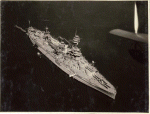 |
361k | Pre WW II aerial photo of the Texas (BB-35). Date is prior to April 1935, for it was during April through August at Bremerton Navy Yard that the birdbath platforms were installed atop both masts. As to a more specific date; I am perplexed by the absence of 50cal AA guns on the aft platforms of the Flag Bridge, referred to at this time as the AA Gun Platform. I do not know when the guns were installed. Renown 1920s-1930 model builder Armitage McCann has them on his 1931 Texas model. Maybe the photo predates the 50cal guns being aboard? |
USN photo courtesy of Robert M. Cieri. Text courtesy of Chuck Moore. | |
 | 396k | The "birdbath" .50 cal platform above the fore top makes this photo 1935 or later. | Photo i.d. courtesy of Richard M. Jensen. Photo courtesy of Ric Hedman. |
|
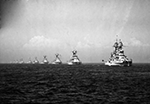 | 274k | US Navy battleships in parade formation in San Diego, California, 23 August 1935. Pennsylvania (BB-38) in the lead followed by West Virginia (BB-48), Colorado (BB-45), Maryland (BB-46), California (BB-44) and Texas (BB-35). The ship behind the Texas appears to be the New York (BB-34). You can see a shadow on the forward fighting top consistent with the forward-facing bathtub that New York had, plus you can barely make out the double turrets. | Photo i.d. courtesy of Richard Jensen with an assit from Richard McSlick. USN photo # 80-G-462946 from the National Museum of the U.S. Navy via flickr.com. | |
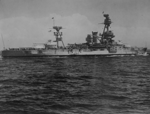 013514g |
3.66k | The battleship Texas (BB-35), starboard view, 23 August 1935. | National Archives Identifier: 496081336 Local Identifier: 19-N-17195 Photo courtesy of catalog.archives.gov |
|
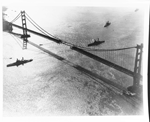 013934 | 6.44k | U.S. Fleet battleships steam under the incomplete Golden Gate Bridge, circa November 1936. Leading ship is Arizona (BB-39), followed by Nevada (BB-36), Maryland (BB-46) and Texas (BB-35) . | Photo NH 95911, courtesy of history.navy.mil | |
 | 1.30k | A Texas (BB-35) sized broadside photo circa 1937-38. The O3U planes were replaced by SOC in early 1939 and the 0.50 cal MG tubs atop both the masts were added in 1937 (maybe 1936). The E does not stand for enormous. | Text i.d. courtesy of Chris Hoehn. Photo courtesy of the late Robert Wilmes, submitted by his son, Dan Wilmes. |
|
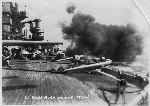 | 38k | 14" guns roar on the Texas (BB-35). Visible in the photo are post-modernization additions: air-castle for the moved 5"battery, tripod mast, aircraft catapult and after fire control tower. | USN photo courtesy of Pieter Bakels. Text i.d. courtesy of Chris Hoehn. |
|
 | 1.97k | Texas (BB-35) at Pearl Harbor, probably summer 1937. | Photo courtesy of Roger Reynolds. Photo i.d. courtesy of Richard Jensen. |
|
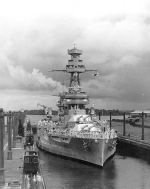 | 111k | Texas (BB-35) as seen on 21 June 1937 in the Panama Canal Gatun Locks. The "bird bath" on top of her fire controls contains 0.50 caliber machine guns. The standard 20 foot range finder is prominent atop her bridge. | USN photo. | |
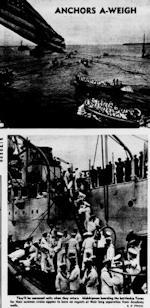 | NR | They'll be seasoned salts when they return. Midshipmen boarding the battleship Texas (BB-35) for their summer cruise appear to have no regrets at their long separation from Academy walls. | Image provided by: Library of Congress, Washington, DC. Photo & text by Evening star. [volume] (Washington, D.C.) 1854-1972, 12 June 1938, Image 96, courtesy of chroniclingamerica.loc.gov. | |
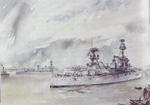 013513f | 1.42k | A painting by Ian Marshall of the modernised battleship Texas (BB-35) at Portsmouth, England, 1938. In the background is the Royal Navy light cruiser HMS Emerald. | Text Images from Victory at Sea: Naval Power and the Transformation of The Global Order in World War II, by Paul Kennedy with paintings by Ian Marshall. Pub: Yale University Press, New Haven and London. Library of Congress Control Number: 2021454849, via Robert Hurst. | |
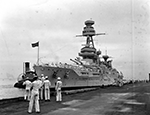 | 922k | Texas (BB-35) in port in Norfolk, Virginia, 18 August 1938. | Photo from The Virginian-Pilot Photograph Collection / SMC Photograph Collection from the Norfolk Public Library (Va.) via Andrew Payne. | |
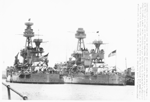 | 312k | Norfolk VA., 13 April 1939. "Texas (BB-35) is bounded by New York (BB-34)". At least the battleships of those names are neighbors, as they stand tied up at Hampton Roads here during yesterday's preliminary off the Virginia capes. Janes Fighting Ships authority on the world's fighting battle craft, describes the Texas & New York as slow, hard to handle and bad sea boats in rough weather. | A.P. Wire photo from the collection of Michael Strout, courtesy of Jonathan Eno. | |
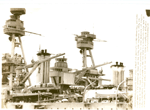 | 445k | Norfolk VA., 13 April 1939. "Steel forest for Americas shores". Menacing, gun laden tripod masts of the battleships Texas (BB-35) & New York (BB-34), both completed in 1914, are shown here as fleet began to arrive here yesterday for naval maneuvers off Virginia capes, preparatory to grand parade to N.Y. late this month. Both ships have 10 14" guns, 16 5" guns, and each can carry 3 aircraft. | A.P. Wire photo from the collection of Michael Strout, courtesy of Jonathan Eno. | |
 013530l |
2.82k | Passing Statue of Liberty, New York City. | National Archives Identifier: 496081313 Local Identifier: 19-N-1455 Photo courtesy of catalog.archives.gov | |
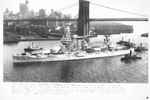 | 285k | N.Y. 22 April 1939."Inward Bound". Most moving warships on the Atlantic coast have been outward bound, under orders returning the U.S. fleet to the Pacific, but here's the battleship Texas (BB-35), one of the vessels scheduled to be on hand when the World's Fair opens, seen as she passed under the Brooklyn Bridge today on her way to a berth at the Navy Yard. In the background is the Brooklyn skyline. | A.P. Wire photo from the collection of Michael Strout, courtesy of Jonathan Eno. | |
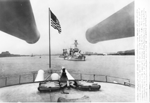 | 177k | N.Y. 29 April 1939. "Fleet steams up Hudson". Thirty seven vessels of the Atlantic Squadron steamed through N.Y. harbor and up the Hudson River today as part of the ceremonies connected with tomorrow's opening of the World Fair. This striking picture made from the deck of the New York (BB-34) flagship, shows the Texas (BB-35) followed by the Tennessee (BB-43). | A.P. Wire photo from the collection of Michael Strout, courtesy of Jonathan Eno. | |
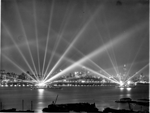 | 221k | N.Y. 3 May 1939."The Navy's eyes probe the sky". Two battleships [looks to be the Texas (BB-35) & New York (BB-34)] of the Navy's Atlantic squadron made this pretty picture on the Hudson when their huge searchlights were played across the sky in search of imaginary aerial attackers. The lights of New York's myriad skyscrappers twinkle through from the background. | A.P. Wire photo from the collection of Michael Strout, courtesy of Jonathan Eno. | |
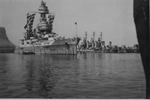 |
453k | Two stack destroyers astern a flag drapped Texas (BB-35), circa 1940s. | Photo courtesy of texashistory.unt.edu. via Daniel Hacker. | |
 |
178k | Arkansas (BB-33) & Texas (BB-35) sail in tandem.Arkansas departed Norfolk on 11 January 1940, in company with Texas and New York, and proceeded thence to Guantanamo Bay for fleet exercises. The easiest feature for distinguishing the Texas from the New York is the size of the navigation bridge which is located in the foremast one platform level above the roof of the conning tower. The bridge of the New York is short and extends only to the aft edge of the conning tower. The Texas' bridge extends to the forward edge of the conning tower with a single stanchion supporting its forward edge. These enclosed navigation bridges were added in 1917 at the "suggestion" of the Royal Navy who expressed the opinion that the open deck bridges found on American warships would be ill-suited for sailing in the North Sea or North Atlantic - they were right. |
USN photo courtesy of Robert M. Cieri. Partial text courtesy of DANFS. Photo i.d. & text courtesy of Chris Hoehn. | |
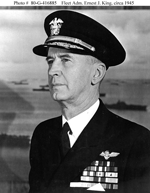 | 79k | History indicates a continuous use of the title "Commander in Chief, Atlantic Fleet" from 1906 until 1923 and again from 1941 to 2002. In a reorganization of the United States Fleet in 1923, that title was abolished and the title Commander Scouting Force was used. On 1 February 1941, General Order 143 reestablished the title and reorganized the United States Fleet into three separate fleets (Atlantic, Pacific and Asiatic). The Order further stated each fleet would be under the command of a full admiral. Thus, on 1 February 1941, Rear Admiral Ernest J. King, in his flagship Texas (BB-35) at Culebra, Puerto Rico, hauled down his two-star flag and hoisted his four-star flag as Commander in Chief, United States Atlantic Fleet. | Naval History and Heritage Command photo # 80-G-416885 via Bill Gonyo. | |
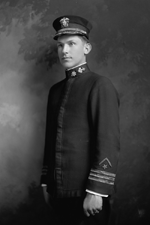 | 88k | Capt. Clarence Nelson Hinkamp was the Commanding Officer of the battleship Texas (BB-35) from 31 May 1940 to 2 August 1941. | Photo from the Library of Congress via Bill Gonyo. | |
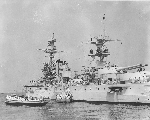 | 490k | Photo taken 8 June 1940, as Texas (BB-35) takes on midshipmen from the U.S. Naval Acadamy for their summer cruise. This may have been the last pre-war midshipman cruise due to World War II. Note that she still has the range clock, her open casemates, and what looks like an admiral's flag flying from the mainmast. | International News Photo & text courtesy of David Buell. | |
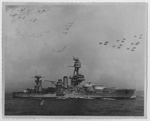 | 559k | Texas (BB-35) on Navy Day, 27 October 1940. | Source: United States National Archives, Photo No. 80-G-464121 via Mike Green. | |
 | 63k | Silhouetted against the sunset, while participating in North Atlantic convoy operations, circa summer 1941. Photographed by Lieutenant Dayton A. Seiler, USN. | Official USN photo Naval History and Heritage Command # 80-G-K-387, now in the collections of the National Archives. | |
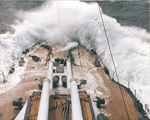 | 333k | Texas (BB-35) takes water over the bow in this 1941 photo. | Photo by LCDR Charles W. Moses, Gunnery Officer Texas from 2 January 1941 until 18 February 1943. Photo i.d. courtesy of Jim Moses, CDR, USN (Retired). He was always behind the camera. All I have (that I know of - I still find stuff in my mother's things) from his Texas days is this one of his desk (that's her) taken by a LIFE photographer. The tall building in the picture is in his hometown, Bismarck, ND. USN photo courtesy of Pieter Bakels. |
|
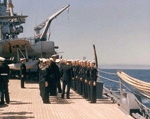 | 326k | Inspection time on the fantail of the Texas (BB-35) sometime in 1941. | Photo by LCDR Charles W. Moses, Gunnery Officer Texas from 2 January 1941 until 18 February 1943. Photo i.d. courtesy of Jim Moses, CDR, USN (Retired) USN photo courtesy of Pieter Bakels. | |
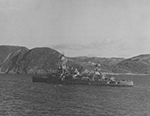 |
408k | 3/4 rear view of Texas (BB-35) in Prentice Bay, Newfoundland, on 14 October, 1941. | USN photo # 80-G-464617 now in the collection of the US National Archives in College Park, Maryland, courtesy of Sean Hert. | |
| WW II |
||||
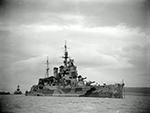 | 385k | As seen from the HMS Victorious (R-38),the HMS Renown and Texas (BB-35) are moored in Hvalfjord, Iceland in late January, 1942. The two British ships have just returned from patrols searching for the German battleship Tirpitz. The Texas has just arrived in Iceland from Argentia, Newfoundland and is preparing to continue on escorting a convoy to Great Britain. | Source: Imperial War Museum Admiralty Official Collection by Parnell, C.H. (Lt), Photo No. © IWM(A 7322) © courtesy of Mike Green. | |
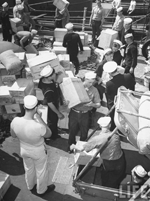 | 163k | Supplies being loaded onto Texas (BB-35). | Photographer: Frank Scherschel, courtesy of life.time. Photo i.d. courtesy of Travis Davis, Curatorial Assistant for Collections and Restoration, Battleship TEXAS State Historic Site. | |
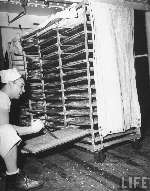 | 168k | Mess cook cutting cake in bakery shop aboard Texas (BB-35). The baker picture is not actually in the Bakery, but outside in the port Aircastle. Because of the size constraints of the Bakery, the bakers set the cooling racks in the Aircastle to cool bread or in this case corn bread. Quite a few of our veterans tell us about seeing guys wearing pea coats in the summer and swiping some bread. | Photographer: Frank Scherschel, courtesy of life.time. Photo i.d. & text courtesy of Travis Davis, Curatorial Assistant for Collections and Restoration, Battleship TEXAS State Historic Site. | |
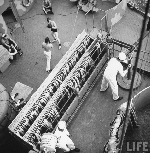 | 223k | Overhead view of US sailors manning the signal bridge of Texas (BB-35). Note the sailors below sparring in an improvised ring. On the Signal Bridge you can actually see Texas written on the life ring that is hanging on the splinter screen in the upper left hand corner of the picture. | Photographer: Frank Scherschel, courtesy of life.time. Photo i.d. & text courtesy of Travis Davis, Curatorial Assistant for Collections and Restoration, Battleship TEXAS State Historic Site. | |
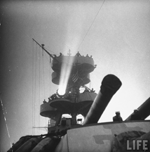 | 155k | Searchlight shining through fog from tower of Texas (BB-35) in 1942. The Main Mast is definitely that of Texas due to the configuration of the Search Light Platform in relation to the Movie Operating Platform (or so the 1942 Booklet of General Plans for New York (BB-34) calls it). In New York there is not a space between the Search Light Platform and the Movie Operating Platform like there was on Texas. | Photographer: Frank Scherschel, courtesy of life.time. Photo i.d. courtesy of Travis Davis, Curatorial Assistant for Collections and Restoration, Battleship TEXAS State Historic Site. | |
 | 618k | Imagine this is the New York (BB-34) while looking at a broadside of the Texas (BB-35). | Official USN photo courtesy The Ships and Aircraft of the United States Fleet by Admiral James C. Fahey, courtesy of Tommy Trampp. | |
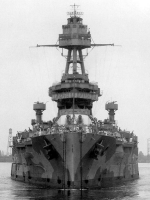 | 83k | Bow on view of Texas (BB-35) at the Norfolk Naval Yard, Portsmouth Virginia, 19 August 1942. | USN photo. | |
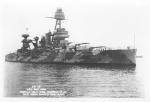 | 80k | Starboard bow view of the Texas (BB-35) at the Norfolk Naval Yard, Portsmouth Virginia, 19 August 1942. | USN photo courtesy of David Buell. | |
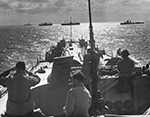 |
313k | On 23 October, Texas (BB-35) embarked upon her first major combat operation when she sortied with Task Group (TG) 34.8, the Northern Attack Group for Operation Torch, the invasion of North Africa. The objective assigned to this group was Mehedia near Port Lyautey and the port itself. The ships arrived off the assault beaches early in the morning of 8 November and began preparations for the invasion. When the troops went ashore, Texas did not come immediately into action to support them. At that po int in the war, amphibious warfare doctrine was still embryonic; and many did not recognize the value of a pre-landing bombardment. Instead, the Army insisted upon attempting surprise. Texas finally entered the fray early in the afternoon when the Army requested her to destroy an ammunition dump near Port Lyautey. For the next week, she contented herself with cruising up and down the Moroccan coast delivering similar, specific, call-fire missions. Thus, unlike in later operations, she expended only 273 rounds of 14-inch and 6 rounds of 5-inch. During her short stay, some of her crew briefly went ashore to assist in salvaging some of the shipping sunk in the harbor. On 16 November, she departed North Africa and headed for home in company with Savannah (CL-42), Sangamon (ACV-26), Kennebec (AO-86), four transports, and seven destroyers. A view forward from the 20MM tub on top of turret #2 as Massachusetts (BB-59) heads into the sun on 4 November 1942, just before the Battle of Casablanca. "Lead Dammit Lead" is stenciled on the 20mm gun shield and Texas is at left, in the distance. |
Text courtesy of DANFS. USN photo # 80-G-264953 now in the collection of the US National Archives in College Park, Maryland, courtesy of Tracy White @ Researcher @ Large. | |
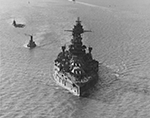 |
408k | Bow view of Texas (BB-35) on 15 December, 1942. | USN photo # 80-G-33844 now in the collection of the US National Archives in College Park, Maryland, courtesy of Sean Hert. | |
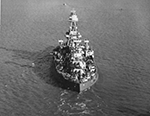 |
393k | Stern on Texas (BB-35), 15 December, 1942. | USN photo # 80-G-33845 now in the collection of the US National Archives in College Park, Maryland, courtesy of Sean Hert. | |
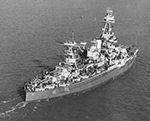 |
467k | Starboard quarter of the Texas (BB-35), 15 December, 1942. | USN photo # 80-G-33843 now in the collection of the US National Archives in College Park, Maryland, courtesy of Sean Hert. | |
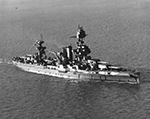 |
466k | Broad on starboard bow view of Texas (BB-35), 15 December, 1942. | USN photo # 80-G-33842 now in the collection of the US National Archives in College Park, Maryland, courtesy of Sean Hert. | |
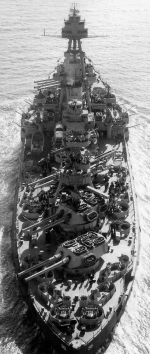 | 83k | Underway, 15 March 1943, all turrets are trained sharply to port. | USN photo. | |
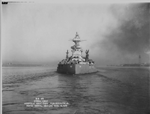 | 202k | Stern view of the Texas (BB-35), 15 March 1943. | USN photo serial # 4841-43, courtesy of Ed Zajkowski. | |
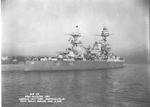 | 235k | Starboard quarter view, 15 March 1943. | USN photo serial # 4840-43, courtesy of Ed Zajkowski. | |
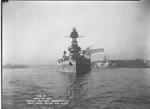 | 444k | Head on view, 15 March 1943. | USN photo serial # 4837-43 courtesy of Ed Zajkowski. | |
 | 240k | Texas (BB-35) broadside, March 1943. | Photo i.d. courtesy of Randall Chisum. Photo # 80-G-229725 (inset) / 419699 from NARA, College Park, Maryland, courtesy of Sean Hert. | |
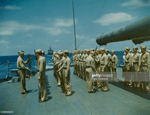 013594 |
2.10 | Marines aligning on deck of Texas (BB-35) on an Atlantic convoy at Sea, 1943. | Photo by Frank Scherschel/The LIFE Picture Collection via Getty Images courtesy of gettyimages.com. | |
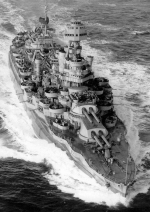 | 120k | Underway near Casco Bay, Maine, prior to 25 January 1944. On 25 January 1944, Texas (BB-35) entered Boston Navy Yard, where among other changes, the SC-1 radar antenna atop the foremast was removed and the SG antenna which is below the 3-tier fire control structure, was relocated atop the foremast. The date is after June 1943 for this is when the quad 40mm guns (among other guns) were installed, in Boston Navy Yard (1 - 30 June 1943). | Text contributed by Chuck Moore. USN photo. | |
 | 55k | Texas (BB-35) at anchor in the Clyde River, Scotland after escorting a troop convoy to the British Isles. A British escort carrier is in the background. The date is after 1943. Texas was in the Clyde in July 1942, January 1944 and April 1944. With the foremast SG being atop the fire control structure, the image is after February 1944,for it was in a Boston Navy Yard period of January - February 1944 that the SG antenna was relocated atop the foremast. | Text contributed by Chuck Moore. USN photo contributed by Mike Green, courtesy of Leeward Publications. | |
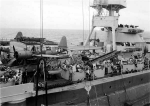 | 38k | Texas (BB-35) with OS2U on after catapult. Date should be late April 1944. Note that the forward and after portions of the A/C catapult have been dismounted from the #3 Turret. (The forward portions is the structure sitting on the port quarter deck.) These and the Kingfishers were landed in Belfast prior to Normandy invasion. Spotter pilots from the BB's and CA's flew Mustangs and Spitfires over the beach head.The dismounted catapult and A/C on the deck would make the probable location in the Irish Sea on the trip from the Clyde to Belfast. The Texas appears fueling an accompanying escort (fuel line hanging from boat crane in lower left) | Courtesy of Joe F. Powers. Photo i.d. & text courtesy of Chris Hoehn. | |
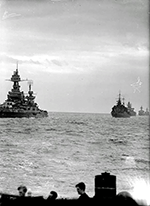 | 424k | Allied warships of Bombarding Force 'O', supporting the landings on Omaha area. The column is led by Texas (BB-35), (left) with HMS Glasgow, Arkansas (BB-33), FFS Georges Leygues and FFS Montcalm following. | Source: Imperial War Museum Admiralty Official Collection, Photo No. © IWM (A 23923), courtesy of Mike Green. | |
 |
393k | D-Day ammunition expended by ship of the Bombarding Force 'O', above. | From "Report of Naval Operations in the invasion of Normandy, France, 6/6/44-7/3/44" issued by Allied Naval Commander-In-Chief, Expeditionary Force. courtesy of Tracy White @ Researcher @ Large. | |
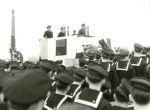 | 98k | Gen. Dwight D. Eisenhower addresses the crew of the Texas (BB-35) prior to the Normandy landing. Texas supported the Omaha Beach landings. | Photo courtesy of USN/USNI. | |
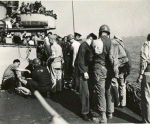 | 91k | Navy corpsmen treat wounded U.S. Army Rangers aboard the Texas (BB-35). | Photo courtesy of USN/USNI. | |
 | 294k | LST 388 probably at Normandy on 7 June 1944. On 2 June LST 388 embarked 23 officers, 338 men, and 70 vehicles of the 187th field artillery battalion, bound for Omaha Beach. They also took a pontoon and rhino ferry (possibly seen here) in tow. Enroute, the ship encountered unpleasant weather conditions and many of the troops suffered seasickness. LST 388 anchored in the assault area at 1215 on 7 June at which time the rhino ferry was slipped. LST 388 remained at anchor overnight while allied warships carried out a heavy bombardment of shore installations. In this photo, smoke from a volley of fire from one of those warships (probably Texas (BB-35)) is clearly visible behind LST 388. | USN photo & text courtesy of Brian Miller via Gary Priolo. | |
 | 55k | Oil on canvas painting by the artist Randall Wilson entitled "Gunline Omaha". In support of the American landings at Utah and Omaha beaches, the Texas (BB-35) slugs it out with German heavy gun emplacements during the D-Day landings. | Text and painting courtesy of naval-art.com | |
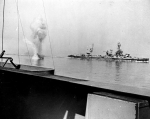 | 81k | A heavy German coast artillery shell falls between Texas (BB-35), in the background, and Arkansas (BB-33), while the two battleships were engaging Battery Hamburg during the bombardment of Cherbourg, France, 25 June 1944. Photographed from Arkansas. | Naval History and Heritage Command # 80-G-244210, now in the collections of the National Archives. | |
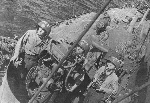 | 45k | Sky watch on board the Texas (BB-35). June 1944 PDF deck logs for the Texas. | USN photo courtesy of Pieter Bakels. PDF courtesy of Joe Reese. |
|
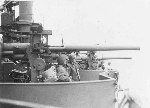 | 39k | Crew members of a 5/51" pause for conversation during gunnery practice. | Photo i.d. courtesy of Ron Balko. USN photo courtesy of Pieter Bakels. |
|
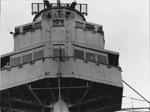 | 152k | Here's looking at you from the Texas (BB-35) bridge, 1944. | Photo # 80-G-352839 from NARA, College Park, Maryland, courtesy of Sean Hert. | |
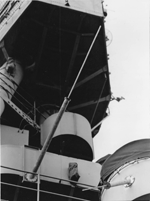 | 155k | Tall, dark & underside of the Texas (BB-35) bridge, 1944. | Photo # 80-G-352838 from NARA, College Park, Maryland, courtesy of Sean Hert. | |
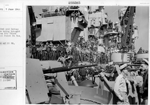 | 732k | Slow moment on Texas (BB-35), 7 June 1944. | Photo # 80-G-235585 from NARA, College Park, Maryland, courtesy of Sean Hert. | |
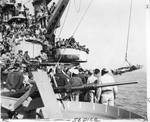 | 921k | Wounded in France, U.S. Army Rangers are carefully hoisted aboard the battleship Texas (BB-35) after a speedy trip out from the embattled shoreline in landing craft. The casualties were quickly given medical treatment on the giant ship. | USN photo courtesy of flickr.com via Robert Hurst. | |
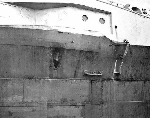 | 36k | Texas (BB-35) wearing the results of German gunnery during close-in fire support off Cherbourg, 26 June, 1944. | USN photo courtesy of Pieter Bakels. | |
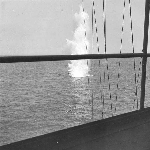 | 41k | Shell splash from what might be a 240-millimeter armor-piercing shell lands near the Texas (BB-35) from German gunnery during close-in fire support off Cherbourg, 26 June, 1944. | USN photo courtesy of Pieter Bakels. | |
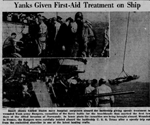 013506 |
NR | Yanks Given First-Aid Treatment on Ship Insert shows United States navy hospital corpsmen aboard the battleship Texas (BB-35) giving speedy treatment to wounded Yank army Rangers, casualties of the fierce battle for the beachheads that marked the first few days of the Allied invasion of Normandy. In lower photo the casualties are being brought aboard. Wounded in France, the Rangers were carefully hoisted aboard the battleship Texas after a speedy trip out from the embattled shoreline in one of the latest landing crafts. | Image and text provided by University of Nebraska-Lincoln Libraries, Lincoln, NE. Photo courtesy of The Frontier. (O'Neill City, Holt County, Neb.) 1880-1965, 06 June 1944, Image 7, via chroniclingamerica.loc.gov. | |
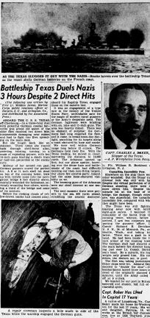 | NR | AS THE TEXAS (BB-35) SLUGGED IT OUT WITH THE NAZIS Smoke hovers over the battleship Texas as the vessel shells German batteries on the French coast. A repair crewman inspects a hole made in side of the Texas while the warship engaged the German guns. | Image and text provided by Library of Congress, Washington, DC. Photo from Evening Star. [volume] (Washington, D.C.) 1854-1972, 14 August 1944, Image 14, via chroniclingamerica.loc.gov. |
|
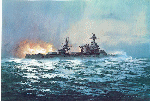 | 41k | The battleship Texas (BB-35) fires her main batteries in this painting by the artist Carl G.Evers. | USN photo courtesy Pieter Bakels. | |
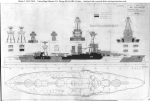 | 124k | Drawing prepared by the Bureau of Ships for Camouflage Measure 31a, Design 8B intended for the battleships New York (BB-34) and Texas (BB-35). This plan, approved by Captain Torvald A. Solberg, USN, is dated 11 October 1944. It shows the ship's starboard side, exposed decks and superstructure ends. New York wore this pattern in late 1944 and early 1945. Texas was painted in it for a brief period during the final part of 1944. | Official USN photo # 19-N-73641, from the Bureau of Ships Collection in the U.S. National Archives. | |
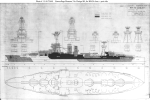 | 117k | Drawing prepared by the Bureau of Ships for Camouflage Measure 31a, Design 8B intended for the battleships New York (BB-34) and Texas (BB-35). This plan, approved by Captain Torvald A. Solberg, USN, is dated 11 October 1944. It shows the ship's port side, exposed decks and superstructure ends. New York wore this pattern in late 1944 and early 1945. Texas was painted in it for a brief period during the final part of 1944. | Official USN photo # 19-N-73640, from the Bureau of Ships Collection in the U.S. National Archives. | |
 013513s |
603k | Texas (BB-35) entering New York City on 24 October 1944. She arrived at the New York Navy Yard for repairs and a refit on 14 September. She also received her final wartime alteration in preparation for the Pacific theater. She departed for the Panama Canal on 10 November. Note: she is painted in Camouflage Measure 31, Design 8B. There are only three known photos of Texas in the measure, this one being third. I uncovered it in one of my online searches. | Photo courtesy of dr.library.brocku.ca via Daniel Hacker. | |
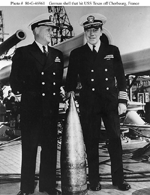 | 60k | Rear Admiral Carleton F. Bryant, USN (left)and Captain Charles A. Baker, USN, Commanding Officer, Texas (BB-35). On board Texas with a German 240mm (9.4") dud shell that hit the ship during the bombardment of Battery "Hamburg", east of Cherbourg, France, on 25 June 1944. Photographed while Texas was undergoing overhaul at the New York Navy Yard on 12 October 1944. | Official USN photo 80-G-46961, now in the collections of the National Archives courtesy of Bill Gonyo. | |
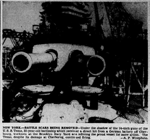 013521d | NR | NEW YORK.óBATTLE SCARS BEING REMOVEDóUnder the shadow of the 14-inch guns of the Texas (BB-35), 32-year-old battleship which received a direct hit from a German battery oft Cherbourg, workmen at the Brooklyn Navy Yard are refitting the proud vessel for more action. The Texas, despite its damage at Cherborug, continued firing. | A .P. Wirephoto Image and text provided by Library of Congress, Washington, DC. Photo from Evening Star. [volume] (Washington, D.C.) 1854-1972, 13 October 1944, Image 5, via chroniclingamerica.loc.gov. |
|
 | 1.10k | The battleship Texas (BB-35) all dressed up in Camouflage Measure 31a, Design 8B in this painting by the artist Carl G.Evers. | USN photo courtesy Pieter Bakels. | |
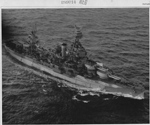 | 831k | Texas (BB-35) underway off the Maine coast (43-40N; 70-03W), 1 November 1944. She is painted in Camouflage Measure 31a, Design 8B. | USN photo # 80-G-289714, from NARA, College Park, Maryland, courtesy of Sean Hert. | |
 |
327k | Texas (BB-35) nears San Pedro, California, where she refueled and trained before departing for Hawaii on 3 December 1944. | USN photo # 80-G-288338 now in the custody of the US National Archives, College Park, Maryland, courtesy of Tracy White @ Researcher @ Large. | |
 | 99k | Oil on canvas print by the artist Tom Freeman entitled "The Pacific Lone Star". This painting depicts the Texas (BB-35) bombarding Iwo Jima, 19 February 1945. | Photo and text courtesy of oldgloryprints.com | |
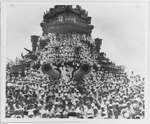 |
614k | From the Texas (BB-35) you can see Oklahoma. | Naval History and Heritage Command photograph NH 119230 via Daniel Hacker. | |
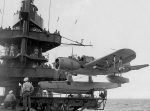 | 77k | An OS2U Kingfisher scout plane is seen before launch atop the middle turret while at Iwo Jima, February 1945. | USN photo. | |
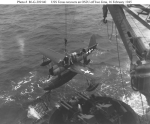 |
72k | Texas (BB-35) recovers a Vought OS2U "Kingfisher" floatplane in a light rain at 1700 Hrs. on 16 February 1945, the first day of the Iwo Jima pre-invasion bombardment. The OS2U's radioman is riding the wing after hooking the plane to the recovery crane. Note details of the crane, aircraft recovery mat and net, 40mm quad gun mounting and the plane's color scheme and markings. | Naval History and Heritage Command photograph # 80-G-309140. Official USN photo now in the collections of the National Archives. | |
 | 368k | Even Texas (BB-35) needs to drink oil. The following two photos show the view from up above as seen from Ltjg Lloyd LaVack's camera. He was an Engineer Officer on Taluga (AO-62). In this view the battleship's crew is hauling the refueling hoses on board Texas on 15 April 1945. View amidships from the Main Mast. | LaVack picture courtesy of Tommy Trampp. | |
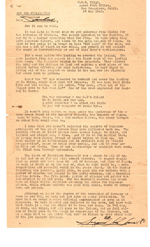 013515b | 1.28k | The real times of Texas (BB-35) in Okinawa. | Photo courtesy of Paul Rock. | |
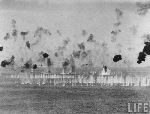 | 135k | Japanese Kamikaze pilot (L, between 2 black puffs, just above waterline) flying through hail of machine gun & antiaircraft fire from the battleship Texas (BB-35), which succeeded in downing the plane. | Photographer: possibly Frank Scherschel, courtesy of life.time. | |
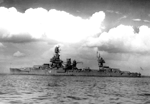 | 480k | The battleship Texas (BB-35) at the end of the war in Measure 21. | Photo courtesy of David Buell. | |
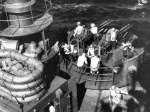 | 83k | A quad 40mm Bofors crew, note the life raft stowage. Circa 1945. | USN photo. | |
| Post War - Present |
||||
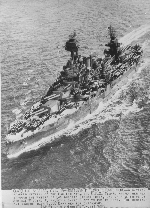 013523b | 2.56k | The Texas (BB-35) steams into the port of Los Angeles, California, sometime in mid October 1945. Over 5 ships brought 9,000 soldiers back from the Pacific. She is also seen here leaving the war behind flying 3 flags from her masts. | Insert photo via Paul Rock. Photo courtesy of David Buell. | |
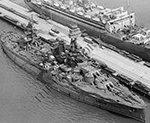 | 687k | Baltimore Sun newspaper photo of Texas (BB-35) docked at Baltimore's Hawkins Point in 1947. Texas was docked at Hawkins Point from June 1946 to January 1948. Across the pier is the troopship George Washington. George Washington burned at that pier on 16 January 1951. The anti-aircraft battery has been removed form Texas but the fire control equipment and radars remain. | Photo from the Baltimore Sun via Joe McDonald. | |
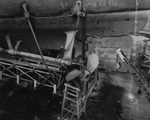 013501b |
605k | Norfolk Navy Yard Workers removing the port propeller from Texas (BB-35), as she is being prepared to serve as a museum ship. This is same propeller she has today. Photographed sometime between 10 January to 17 March 1948. | Photo courtesy of Daniel Hacker. | |
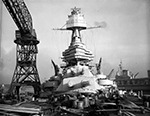 | 1.74k | 14 March 1948 photograph of the Texas (BB-35), at the Norfolk Naval Shipyard in Portsmouth, Virginia. The Franklin D. Roosevelt (CVB-42) appears to her right. | Photo from The Virginian-Pilot Photograph Collection / SMC Photograph Collection from the Norfolk Public Library (Va.) | |
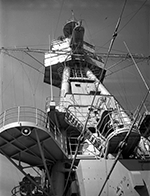 | 1.52k | Things are looking up for Texas (BB-35), 14 March 1948. | Photo from The Virginian-Pilot Photograph Collection / SMC Photograph Collection from the Norfolk Public Library (Va.) | |
 013573b | 280k | The battleship Texas (BB-35) is shown leaving Norfolk Naval Shipyard in March 1948 to begin its journey to the state of Texas, where it was presented as a memorial. Massachusetts (BB-59) sits quietly to her side awaiting her fate that would follow this same journey but back to her home of Massachusetts. | Photo courtesy of USS Massachusetts Museum via Yu Chu. | |
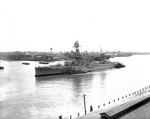 | 429k | Texas (BB-35) is being towed down the Elizabeth River from the Norfolk Naval Shipyard. Its destination is the San Jacinto Battleground State Historic Site at LaPorte, Texas for its final resting space as a ship museum and memorial. The photograph was taken at the foot of North Street in Portsmouth, Virginia. (Date: 3/18/1948). | Photo courtesy of the Norfolk Public Library via Bill Gonyo. | |
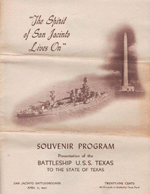 |
470k | Decomm Program Front Page of the Texas (BB-35) on 21 April 1948. | Photo courtesy of Ron Reeves (of blessed memory) via ebay.com. | |
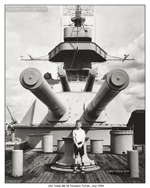 | 510k | A boy & his boat, 1959 photo of the Texas (BB-35) starring the future Carl Kracht, USN, CTT2. | Photo courtesy of Ken Krach & Carl Kracht, USN, CTT2. | |
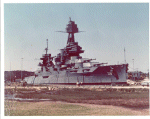 | 163k | Bow on view of Texas (BB-35) at her home in La Porte, Texas. 1968. | Ronald Barker, Capt USAF (Retired) | |
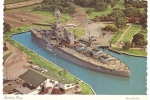 | 175k | Portside view of the Texas (BB-35) as she appeared in 1970 at San Jacinto. | Photo by Atlanta News Agency, Inc, courtesy of David Buell. | |
 | 166k | Texas (BB-35) as she appeared in 1970 at San Jacinto. | Photo by W.M. Cline Co., Cline Photo, Inc, courtesy of David Buell. | |
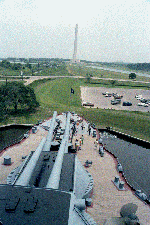 | 597k | A view of the San Jacinto Battlefield Memorial 1 January 1980 from the memorial battleship Texas (BB-35) . The ship's forward 14-inch/45-caliber guns are in the foreground. | USN photo # DN-SC-86-04738 by PH1 Dave MacLean from the Department of Defense Still Media Collection, courtesy of dodmedia.osd.mil.& submitted by Robert M. Cieri. | |
 013581 | 519k | 5 photo PDF of Texas (BB-35) in Galveston getting ready for dry docking in 1989. | Credit: Ryan D. via Yu Chu. | |
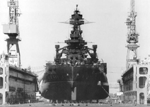 | 162k | Bow view of the Texas (BB-35) in dry dock at Todd Galveston in 1989. The Texas had been moved from the San Jacinto battleground to Todd for much need repair and up keep. | Photo i.d. courtesy of Alan H. Marks. USN photo courtesy of Scott Koen & ussnewyork.com. | |
 | 20k | Commemorative post mark on the occasion of the 50th anniversary on the attack of Pearl Harbor issued for the Texas (BB-35) at her home in La Porte Texas, 7 December 1991. | Courtesy of Jack Treutle (of blessed memory). | |
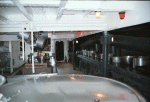 | 53k | The next 9 photos were submitted by Richard Leonhardt, Capt Navy (Retired) at her home in La Porte, Texas. May 2002. The Galley of the Texas (BB-35) . | Richard Leonhardt, Capt Navy (Retired). | |
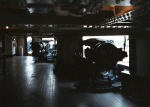 | 50k | Gun deck. | Richard Leonhardt, Capt Navy (Retired). | |
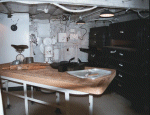 | 64k | Bakery. | Richard Leonhardt, Capt Navy (Retired). | |
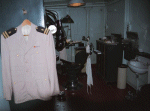 | 46k | Dental clinic. | Richard Leonhardt, Capt Navy (Retired). | |
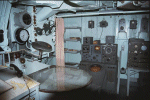 | 76k | CIC. | Richard Leonhardt, Capt Navy (Retired). | |
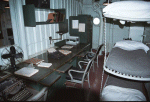 | 71k | Medical administration office. | Richard Leonhardt, Capt Navy (Retired). | |
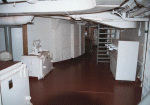 | 51k | Main passageway. | Richard Leonhardt, Capt Navy (Retired). | |
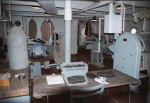 | 63k | Laundry. | Richard Leonhardt, Capt Navy (Retired). | |
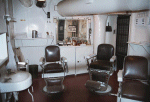 | 62k | Barber shop. | Richard Leonhardt, Capt Navy (Retired). | |
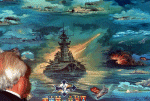 | 376k | A guest studies a painting depicting the history of battleships. The artwork was painted by George Skybeck and presented to the Pearl Harbor Survivors Association during their annual banquet at Honolulu, Hawaii, on 8 December 1991. | USN photo # DN-SC-92-05391, by PHC Carolyn Harris, from the Department of Defense Still Media Collection, courtesy of dodmedia.osd.mil. | |
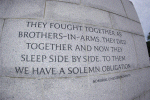 | 371k | A quote made by Fleet Adm. Chester W. Nimitz is inscribed on a granite wall at the National World War II Memorial located on the National Mall in Washington, D.C. Fleet Adm. Nimitz was the United States signatory to the surrender terms aboard the battleship Missouri (BB-63) in Tokyo Bay, Japan on 2 September 1945, thus ending World War II. Established by the American Battle Monuments Commission, the memorial honors all military veterans of World War II, the citizens on the home front, the nation at large, and the high moral purpose and idealism that motivated the nation's call to arms. On 29 May 2004, the memorial was formally dedicated with an estimated 200,000 people expected to attend, and includes 100,000 visiting veterans of all wars. | USN photo # N-0295M-011 by Photographer's Mate 2nd Class Daniel J. McLain, courtesy of news.navy.mil. | |
 | 48k | Commemorative postal cover on the occasion of Texas (BB-35) 90th anniversary, 15 April 2004. | Photo courtesy of Jack Treutle (of blessed memory). | |
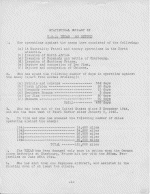 | 85k | PDF of a Personal History of the Texas (BB-35) . | Photo courtesy of Albert Lee Candido via Mike Sharp & submitted by Robert Hall. | 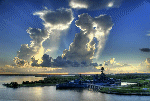 | 194k | Texas (BB-35), 2007. | Photo courtesy of Byron Flynt. | 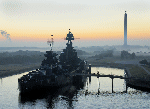 | 194k | Lone star of Texas rises above the San Jacinto Battlefield. | Photo courtesy of Byron Flynt. | 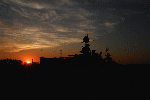 | 154k | Wonderful image taken as the sun is setting. It brings out details and alters her appearance. | Photo courtesy of Byron Flynt. | 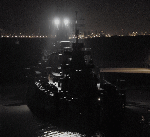 | 135k | Night time in Texas. | Photo courtesy of Byron Flynt. |
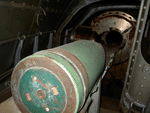 | 332k | Main guns have not been fired in anger for over 60 years. | Photo courtesy of Roel Bakels. | |
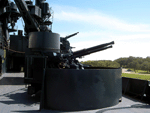 | 269k | 40mm tub. | Photo courtesy of Roel Bakels. | |
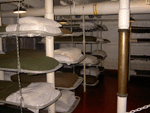 | 260k | Lone Star hotel accommodations. | Photo courtesy of Roel Bakels. | |
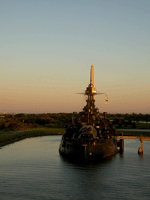 | 255k | The San Jacinto Battlefield monument appears to be incorporated into the Texas (BB-35) mast. | Photo courtesy of Roel Bakels. | |
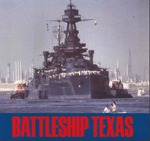 |
18.8k | A brief 160 photo essay on the history of the Texas (BB-35). Graphic heavy link, may take one or two light years to download depending on the speed of your computer. | PDF courtesy of Scott Koen & ussnewyork.com. | |
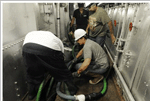 | 154k | Children shimmy up the barrels of massive cannons on the upper decks of the 100-year-old Battleship Texas (BB-35), focused on firing at an imaginary enemy and oblivious to the tension in the historic vessel's belly where a crew works on pumping out dozens of gallons of oil-laced water. The battleship where the young tourists roam became flooded over the weekend. Staff arrived Saturday and immediately noticed something was wrong with the ship that fought in World Wars I and II and has served since 1948 as a memorial and museum to those who sacrificed their lives. The vessel was sitting awkwardly in its slip. She was lower in the water and listing to the left. "We got down to the lower portions of the ship and discovered that we had taken on more water than usual in areas that we normally don't," ship manager Andy Smith said. "They started pumping throughout the day Saturday, and it got progressively worse." The situation was so dire by Sunday that the ship's caretaker, the Texas Parks and Wildlife Department, had to find more pumps to help remove the water. Smith said the news got worse on Monday. Water had entered areas that housed old oil tanks used when the ship was still in active duty and serving in every theater in World War II. The Navy had emptied out the oil before handing the vessel over to Texas, but hadn't cleaned out the tanks. Smith realized he had an environmental issue on his hands. He hired a company to skim the oil off the top of the water and set up boom in case any of it landed in Buffalo Bayou and the Houston Ship Channel. Meanwhile, Smith's pumps are working nonstop to remove the water from the bottom, and at least ensure no more liquids get on the vessel. "It seems like every time we turn around there's more oil because obviously it's very residual but it spreads really nice, especially in this nice Texas heat," Smith said. Until the oil is removed, workers can't get out all the water and look for the source of the problem, which could be several things. It is possible, he said, that the oil will be completely removed by late Wednesday. Then, it should only take a few hours to remove the water, though Smith said he is preparing for the possibility that more water will flow in for a short time after the oil is completely removed due to a change in pressure. Still, he hopes to at least know the source of the problem by Thursday so the crew can begin designing a repair plan. World War II veteran William R. Bradshaw, 87, hopes to be part of the repair effort. On Wednesday, he sat in a shady area of the vessel as rowdy children ran up the ramp. He was waiting to discuss with Smith whether the epoxy his plastics company produces can seal the holes, as it did in 1985 when the battleship had a five-month leak that befuddled the crew. "I've always thought that I would develop a product that would be dedicated to the Navy," Bradshaw said, proud that his company, Bradco Plastics, Inc., has had a part in ensuring future generations can visit the historic ship. "It's kind of like coming home again because when you spend over two years on one at sea, you get all the cruise experience you really want. So it's something that it's nice to come back to." Smith simply wants to get to the point where he can repair the problem and move ahead with a long-term, multimillion-dollar plan to build a dry berth for the battleship. "It's a mammoth effort to keep her preserved. She is an artifact. She is a museum, too," Smith said, noting that normally artifacts are preserved in a climate-controlled environment, "on velvet, under glass." "She can't be that way. We actually let people play on the artifact, run around on her, and the artifact interacts with the environment in a lot of negative ways," Smith said. "So we rust, constantly rust. There's deterioration, the sun beating down, hot, cold, all of that has an effect, long-term effect, on the ship." | By Ramit Plushnick-Masti via The © Associated Press Photo courtesy of Ron Reeves (of blessed memory). AP Photo/Pat Sullivan. | |
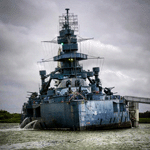 | 459k | 3 photo PDF of Texas (BB-35) after the rain, September 2020. | Photos courtesy of Mike Siegel via Yu Chu. | |
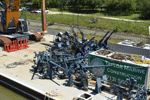 013545 | 550k | 3 photo PDF of Texas (BB-35) anti air weaponry being removed to prepare the ship for dry docking, 30 April 2020. | Photo taken by Julius Taylor via Yu Chu. | |
| Commanding Officers | ||
| 01 | CAPT. Grant, Albert Weston, USN (USNA 1877) :VADM | 12.03.1914 - 10.06.1915 |
| 02 | CAPT. Hood, John, USN (USNA 1879) :RADM | 10.06.1915 - 14.08.1916 |
| 03 | CAPT. Blue, Victor, USN (USNA 1887) :RADM | 14.08.1916 - 31.12.1918 |
| 04 | CAPT. Twining, Nathan Crook, USN (USNA 1889) :RADM | 31.12.1918 - 17.07.1919 |
| 05 | CAPT. Schofield, Frank Herman, USN (USNA 1890) :RADM | 17.07.1919 - 17.06.1921 |
| 06 | CAPT. Kellogg, Edward Stanley, USN (USNA 1892) | 17.06.1921 - 06.07.1922 |
| 07 | CAPT. Proctor, Andr? Morton, USN (USNA 1893) | 06.07.1922 - 22.05.1924 |
| 08 | CAPT. Wettengel, Ivan Cyrus, USN (USNA 1896) | 22.05.1924 - 28.09.1925 |
| 09 | CDR. Blakely, Charles Adams, USN (USNA 1903) :VADM | 28.09.1925 - 02.06.1926 |
| 10 | CAPT. Briggs, Zeno Everett, USN (USNA 1898) | 02.06.1926 - 04.01.1928 |
| 11 | CAPT. DeFrees, Joseph Rollie, USN (USNA 1900) :RADM | 04.01.1928 - 09.07.1929 |
| 12 | CAPT. Andrews, Adolphus, USN (USNA 1901) :VADM | 09.07.1929 - 13.05.1931 |
| 13 | CAPT. Townsend, Julius Curtis, USN (USNA 1902) :RADM | 13.05.1931 - 17.06.1933 |
| 14 | CAPT. Leahy, Lamar Richard, USN (USNA 1903) :RADM | 17.06.1933 - 15.04.1935 |
| 15 | CAPT. Taffinder, Sherwoode Ayerst, USN (USNA 1907) :VADM | 15.04.1935 - 21.11.1936 |
| 16 | CAPT. Rogers, Fred Fremont, USN (USNA 1906) | 21.11.1936 - 01.06.1938 |
| 17 | CAPT. Emmet, Robert Rutherford Morris, USN (USNA 1908) :RADM | 01.06.1938 - 31.05.1940 |
| 18 | CAPT. Hinkamp, Clarence Nelson, USN (USNA 1907) | 31.05.1940 - 02.08.1941 |
| 19 | CAPT. Comstock, Lewis Wells, USN (USNA 1911) | 02.08.1941 - 28.09.1942 |
| 20 | CDR. Hennigar, William Everett, USN (USNA 1923) | 28.09.1942 - 03.10.1942 |
| 21 | CAPT. Wild, Laurence, USN (USNA 1913) | 03.10.1942 - 14.10.1942 |
| 22 | CDR. Hennigar, William Everett 2, USN (USNA 1923) | 14.10.1942 - 17.10.1942 |
| 23 | CAPT. Pfaff, Roy, USN (USNA 1913) | 17.10.1942 - 10.03.1944 |
| 24 | CAPT. Baker, Charles Adams, USN (USNA 1916) | 10.03.1944 - 17.08.1945 |
| 25 | CAPT. Schetky, Gerald Laurence, USN (USNA 1918) | 17.08.1945 - 03.07.1946 |
| 26 | CAPT. Downes, Robert Noble | 03.07.1946 - 06.03.1947 |
| 27 | CAPT. Bagshaw Jr., James R. | 06.03.1947 - 07.04.1947 |
| 28 | CDR. McKee, Samuel Johnson | 07.04.1947 - 31.07.1947 |
| 29 | LCDR. Seward, Jack | 31.07.1947 - 21.04.1948 |
| 30 | CAPT. Baker, Charles Adams, USN (USNA 1916) | 21.04.1948 - 21.04.1948 |
The contact listed, Was the contact at the time for this ship when located. If another person now is the contact, E-mail me and I will update this entry. These contacts are compiled from various sources over a long period of time and may or may not be correct. Every effort has been made to list the newest contact if more than one contact was found.
| Back To The Main Photo Index | Back To The Battleship Photo Index Page |